Inbox and Environment News: Issue 455
June 21 - 27, 2020: Issue 455
Grey Butcherbird: Birds In Your Pittwater Backyard
Grey Butcherbird
The grey butcherbird (Cracticus torquatus) is a widely distributed species endemic to Australia. It occurs in a range of different habitats including arid, semi-arid and temperate zones. It is found across southern Australia, but is absent from the deserts of central Australia and the monsoon tropics of northern Australia. It has a characteristic "rollicking" birdsong. It appears to be adapting well to city living, and can be encountered in the suburbs of many Australian cities including Sydney and Brisbane. The grey butcherbird preys on small vertebrates including other birds.
The grey butcherbird was first described by the English ornithologist John Latham in 1801 under the binomial name Lanius torquatus.
The grey butcherbird is a small grey, black and white bird with a weight of 90 grams (3.2 oz), a body length between 27–30 cm (10.6-11.8 in) and a wing span expanding 37–43 cm (14.6-16.9 in). The grey butcherbird is smaller than the Pied Butcherbird (Cracticus nigrogularis).
The juvenile is slightly different from the adult, as the juvenile does not have a black head, instead the head is a dark brown with fine streaks on the forehead and ear-covers and white loral spots that meet the eyes and bill, as well as having an off-white chin and throat. The upperbody is dark brown with streaks, and the uppertail-coverts are also a dark brown and have a brownish colour at the base of the uppertail. Juvenile's beaks are completely dark grey and often the hook at the tip of the beak is not obvious.
All members of the territorial group contribute to the territorial song, a loud and rollicking song with both musical and harsh elements. The song can be sung by only one member, but more often it is sung in duet or as a group. Some duets are antiphonal where it is not obvious that two or more birds are singing. Most songs are sung with more than one phase and are sung antiphonally. These songs consist of different group members singing different phases sequentially, but sometimes there are some overlap. Some songs have been known to last up to 15 minutes. During this time, there is no vocal interaction with groups from other territories.
The grey butcherbird usually breed in single territorial pairs from July to January. Both sexes defend their territories and nest throughout the year. The female incubates the eggs while the nestlings and fledglings are fed by both parents. The nest is a shallow, bowl-shaped made from sticks and twigs. The nest is lined with grasses and other soft fibres. Nests are normally located within 10 m (32.8 ft) of the ground.
The grey butcherbird is found in a range of habitats, from eucalypt forests and woodlands, mallee and acacia shrublands, rainforests and riparian vegetation to urban areas and residential townships.
Photos by A J Guesdon, June 2020 - Information from BirdLife Australia.
Ku-Ring-Gai Chase National Park Precinct Closures Update
Many COVID-19 restrictions have now been lifted from visitor precincts and facilities In Ku-ring-gai Chase National Park. However, several tracks and trails will remain closed while upgrades and remediation works are completed. These closures include:
- Bobbin Head playground
- Warrimoo walking track - public access may be restricted on Wednesday 17 and Thursday 18 June.
- The Basin trail
- The Basin campground and picnic area
- Mackerel service trail
- Salvation Loop and Wallaroo trails
Berowra track, between Apple Tree Bay and the intersection of Mount Ku-ring-gai track, has now reopened. However if you plan to visit, walk with caution as some sections of the track remain uneven.
Closed areas: The Basin campground, Basin trail and Mackerel service trail closed
The following areas will be closed from Monday 1 June until Monday 3 August 2020 while upgrade works and maintenance are underway:
- The Basin trail
- The Basin campground and picnic area
- Mackerel service trail
No public access is permitted. There will be no access to The Basin Aboriginal Engraving Site, Mackerel Beach to The Basin trail, West Head Road or The Basin campground.
For further information call 02 9451 3479 or 02 9472 8949.
Closed areas: Salvation Loop and Wallaroo Trails closed for maintenance.
The Salvation Loop Trail and Wallaroo Trail at West Head will be closed from 2 June 2020 until early July 2020 for maintenance. Machinery will be on the trails so no public access is permitted for safety reasons.
For further information contact; (02) 9451 3479 or (02) 9472 8949
Please remember to practice appropriate social distancing requirements and good hygiene. From Saturday 13 June, the maximum group size for an outdoor gathering will be increasing from 10 to 20 people. Groups are still expected to maintain social distancing. If you arrive at a national park or other public space and it is too crowded to practice social distancing, it is your responsibility to leave the area. Do not wait to be instructed by NPWS staff or police.
The closure of toilets and other facilities will be decided on a case-by-case basis. Necessary site assessments will take place to consider the management of health and safety risk to visitors and staff, and available resourcing to maintain facilities. Access to sanitation products and running water cannot be guaranteed. We recommend bringing hand soap, hand wipes and toilet paper with you to maintain good hygiene as advised by the NSW Government.
If you're visiting the park, please bring a card to pay vehicle entry fees.
For more information about closures, call the NPWS Contact Centre on 1300 072 757, the NPWS North Western Sydney area office on 02 8448 0400 or the NPWS Sydney North area office on 02 9451 3479.
Penalties apply for non-compliance.
Two Hundred Sea Turtle Hatchlings Cause For Shellebration
June 17, 2020
More than 200 baby sea turtles have safely found their way to the ocean as this year’s NSW sea turtle nesting season comes to close. Seven nests were found on NSW beaches from Tweed to Sydney’s Northern Beaches between November 2019 and May 2020, a significant increase on last year’s numbers.
NSW TurtleWatch Project Officer Holly West said it was wonderful to see green turtles and loggerhead turtles, both threatened species, nesting on northern NSW beaches.
“With an increasing number of threats to sea turtles, including vessel strikes, entanglements and coastal development infringing on nesting grounds, it’s a relief to see them returning to our beaches year after year to lay their eggs.
“The local area NPWS staff and Turtle Watch volunteers have really put in the hard yards this year, spending more than 90 hours monitoring beaches up and down the coast for nesting activity, signs of predation and indicators that eggs have begun to hatch.
“We try to intervene as little as possible, however with so few turtles surviving to adult breeding age, we want to give the baby turtles the best possible chance of survival.
“To have ended the season with 224 hatchlings safely setting off into the ‘big blue’ – that’s a really positive outcome,” said Ms West.
Sand temperatures can influence the gender of hatchlings, with cooler sand temperatures producing males while warmer temperatures produce females.
“Our staff in collaboration with NSW National Parks and Wildlife Service rangers deployed temperature data loggers at each of the NSW nests sites. The cooler temperatures recorded suggest that most likely all of our 224 hatchlings will be male, which is good news for the sea turtle population.
“As global temperatures rise, we are seeing a potential feminisation of our sea turtle populations. Nests in NSW may become critically important in the years to come as a means of maintaining gender diversity in sea turtle populations,” said Ms West.
“We ask beach and water users to be mindful of sea turtles while enjoying NSW’s coastal waters. Keep your eyes peeled for turtle tracks while walking the beach and if you spot some, notify NPWS or Australian Seabird Rescue as soon as you can.
“The sooner you let us know, the quicker we can get down to the beach and ensure the nest is protected. Even just two hours of onshore wind can completely obscure turtle tracks, making it impossible for us to locate and monitor the nest.
“We’ve also seen a number of adult turtles injured after being struck by recreational vessels. If you’re out on the water, designate a lookout for your vessel and consider travelling more slowly in areas where turtles are often sighted.
The NSW TurtleWatch program has been developed by Australian Seabird Rescue and is supported by the NSW Government’s Saving our Species Program and Marine Estate Management Strategy. It is a citizen science program involving volunteers collecting valuable data for marine turtles nesting in NSW and their potential threats.
If you see turtle tracks, hatchlings or injured or dead sea turtles on a NSW beach, contact Australian Seabird Rescue on 0428 862 852 or NSW National Parks and Wildlife Service on 13000PARKS (1300 07275) as soon as possible.
Critically Endangered Shorebirds At Risk From Off-Leash Dogs
June 17, 2020
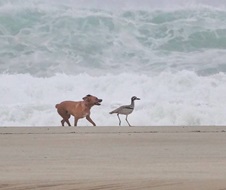 With only eleven breeding pairs of Beach Stone Curlew in NSW, local residents and visitors to Byron Shire are being asked to help protect the critically endangered shorebird by keeping their pets away from shorebird habitat areas. NSW National Parks and Wildlife Service (NPWS) Ranger Team Leader, Jenny Atkins said off-leash dogs are a key threat to curlews and other migratory shorebirds that inhabit Belongil and nearby Brunswick Heads Nature Reserve.
With only eleven breeding pairs of Beach Stone Curlew in NSW, local residents and visitors to Byron Shire are being asked to help protect the critically endangered shorebird by keeping their pets away from shorebird habitat areas. NSW National Parks and Wildlife Service (NPWS) Ranger Team Leader, Jenny Atkins said off-leash dogs are a key threat to curlews and other migratory shorebirds that inhabit Belongil and nearby Brunswick Heads Nature Reserve.
“Shorebirds are wild animals and are very sensitive to disturbances by people, vehicles and animals,” said Ms Atkins.
“An off-leash dog is a terrifying prospect for a shorebird and can cause them to panic and abandon their nests for long periods of time. This can be lethal for eggs and chicks, as they are left vulnerable to predation and harmful weather conditions.
“We’ve also seen shorebird nests crushed, destroyed and, and in some cases, the eggs eaten by off-leash dogs.
“For this reason, off-leash dogs are not permitted in shorebird habitat, including on the beach adjacent to the Belongil Creek estuary or the Brunswick Heads Nature Reserve. The minimum penalty for an off-leash dog in these areas is $300.
NPWS, Cape Byron Marine Park and Byron Shire Council staff regularly patrol these areas and can issue on the spot fines.
“The Belongil breeding pair of beach stone-curlews first began nesting in the area in 2018. Over the past two years, only two chicks have successfully fledged at this site.
“NPWS is also working with the Saving our Species program on a broader conservation project to secure the future of the beach stone-curlew but it’s important that we all do our part to help this threatened species.
“We’re appealing to pet owners to please give the birds space. Ensure your dog remains within designated off-leash zones at Belongil Beach and Brunswick Heads Main Beach,” said Ms Atkins.
Maps of permitted off-leash dog exercise areas in the Byron Shire can be found on the Byron Shire Council website.
You can report illegal activities in Byron National Parks to Tweed Byron Area on (02) 6639 8300 or by emailing npws.tweedbyron@environment.nsw.gov.au
Photo: Off-leash dog chases beach stone-curlew (Esacus magnirostris), Byron Shire Photo: Reid Waters
Upper Hunter MP Michael Johnsen Blasted Over False CSG Complaint Claims
June 16, 2020
NSW farmers are outraged after National Party Member for the Upper Hunter, Michael Johnsen falsely claimed he had not been contacted by farmers worried about the deeply unpopular Santos Narrabri coal seam gas project.
Mr Johnsen made the claims during ABC Country Hour (begins at roughly 7.00) on Monday, saying, in response to whether he’d had any blow back or complaints from farmers, “no I haven’t”.
The comments come after National Party MPs recently sided with their Liberal Party colleagues in the NSW Lower House to vote down a Bill to impose a moratorium on the CSG industry, at least until all of the Chief Scientist’s recommendations were put in place.
Upper Hunter constituent Dr Jacinta Green, representing SOS Liverpool Plains, has since come forward confirming she contacted Mr Johnsen with concerns over the gasfield.
“I was horrified to hear on Country Hour that Michael Johnsen said that he had not heard from one farmer opposed to coal seam gas,” said Dr Green.
“I wrote to Mr Johnsen’s office in early June about the CSG Moratorium Bill, voicing our opposition to CSG and asking him to side with us, farmers of the Liverpool Plains in Mr Johnsen’s own electorate, to abstain from voting against the Bill.
“I am appalled that Mr Johnsen fails to even acknowledge our concerns.”
New TV Ad Promotes Renewable Energy Over Toxic CSG
June 15, 2020
A new TV ad promoting renewable energy as a better choice for NSW’s north west than polluting coal seam gasfields has begun airing on regional television stations Prime7 and NBN.
The ad comes following community outrage over the NSW Planning Department’s decision to label the Santos Narrabri gasfield as “approvable” before referring the project to the Independent Planning Commission on Friday.
It features commentary by Narrabri renewable energy consultant Rohan Boehm and Boggabri farmer Sally Hunter.
“Having an industrialised landscape over a massive, massive area, it totally changes our townships, communities and our way of life,” Mr Boehm said of the proposed gasfield.
Mrs Hunter said Santos’ planned gasfield, which if built would drill 850 CSG wells through the recharge zone for the Great Artesian Basin, wasn’t worth the risk.
“Groundwater is the most precious item that we have and to me, it’s just not worth risking that,” she said.
In 2018, the Renewable Narrabri report found the north west of NSW had enormous renewable energy potential that, if seized, would provide much more opportunities for locals than Santos’ gasfield.
Among the report’s findings was that renewable energy generation projects would use one-twentieth of the land area compared to CSG. Given the recent announcement that insurer IAG will not cover farms with gas wells, renewable generation infrastructure is far lower risk than CSG.
The report also found solar would create four times more long-term jobs than gas without risking groundwater contamination. According to the report, by 2030, there will be just 120 local employees working on the Santos Narrabri gasfield, while there was enough renewable energy potential in the Narrabri local district alone to create 500 direct jobs.
Solar also would not produce the estimated 840,000 tonnes of contaminated salt waste the Santos gasfield would be responsible for, as identified in the NSW Planning Department’s document last week.
The 30-second ad, paid for by Lock the Gate Alliance’s supporters, will be screened in the Dubbo and Orange regions for the next two weeks.
Morrison’s Deregulation Plan = Cutting Corners And Killing Koalas Greens State
June 15, 2020
The Morrison Government’s “deregulation plan” is code for letting big business cut corners at the expense of our environment, the Greens say, pledging to fight the plan in the Parliament.
Greens Spokesperson for the Environment Senator Sarah Hanson-Young said:
“The Morrison Government wants to sacrifice environmental protections so miners and developers can bank bigger profits.
“The push to cut environmental protections for corporate profit is outdated, last century thinking, that will take Australia backwards. Morrison’s plan is a fast-track to the 1950s, not to a modern smarter Australia.
“Our environment laws are already failing to protect Australia’s wildlife. Koalas, native birds and hundreds of other Australian animals need urgent protection from extinction.
“The Government is trying to pre-determine the recommendations of the independent 10-year review into the EPBC Act in favour of more habitat destruction.
“Under the EPBC Act, koalas have already lost one million hectares of critical habitat. Rio Tinto was able to blast away 46,000 years of Indigenous heritage. Water catchments for Sydney have been polluted by dirty coal mines.
“At least 7.7million hectares of critical habitat has been destroyed for mining and development over the last 20 years.
“The Government’s attack on the environment means more dead koalas, more logging and more pollution.
“Using Covid19 as an excuse to scrap environmental protections is an act of bastardry. Most Australians want better protection for the environment, not less. Australians want jobs and projects that look after our forests, beaches and parks, not jobs that trash our environment and kill off our native animals.”
Expensive, dirty and dangerous: why we must fight miners' push to fast-track uranium mines
Gavin Mudd, RMIT UniversityOf all the elements on Earth, none is more strictly controlled under law than uranium. A plethora of international agreements govern its sale and use in energy, research and nuclear weapons.
Australian environmental law considers nuclear actions, such as uranium mining, as a “matter of national environmental significance” under the Environment Protection and Biodiversity Conservation (EPBC) Act. This means uranium involves matters of national and international concern for which the Australian government is solely responsible.
The states, which own minerals, cannot exercise such oversight on uranium exports and use. So any new uranium mine needs both state and federal environmental approvals.
The Minerals Council of Australia wants to change this. In a submission to a ten-year review of the EPBC Act, the council argues that uranium’s special treatment is redundant, as environmental risks are already addressed in state approval processes.
On Monday, Prime Minister Scott Morrison announced that BHP’s proposed expansion of the Olympic Dam copper-uranium-gold-silver mine in South Australia was one of 15 major projects set to be fast-tracked for environmental approval. This would include a single, joint state and federal assessment.
But responsibility and past performance make a compelling case to maintain our federal environmental laws more than ever. Here’s why uranium mining must remain a federal issue.
Our International Obligations
Australia is a signatory to several international treaties, conventions and agreements concerning nuclear activities and uranium mining and export.
These include safeguards to ensure Australian uranium is used only for peaceful nuclear power or research, and not military uses.
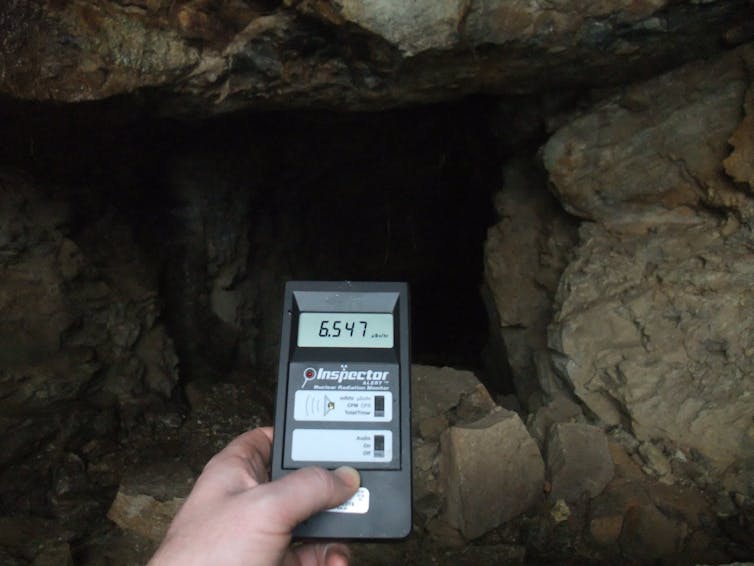
As of the end of 2018, the nuclear material safeguarded under international agreements derived from our uranium exports totalled 212,052 tonnes – including 201.6 tonnes of separated plutonium.
Making sure our uranium trading partners don’t redirect that material for the wrong purpose has been the raison d'être of our nuclear foreign policy since 1977. It’s clearly a national legal and moral obligation, and something the states simply cannot do.
In response, a spokesperson for the Minerals Council of Australia said a national mechanism to manage safeguards already exists through the Australian Safeguards and Non-Proliferation Office, adding:
Uranium is further regulated through the Australian Radiation Protection and Nuclear Safety Agency (ARPANSA) […] under the provisions of the ARPANS Regulations 1999. The object of the ARPANS Act is “to protect the health and safety of people, and to protect the environment, from the harmful effects of radiation”.
But ARPANSA regulates radiation safety and not uranium exports. If uranium mining was removed as a nuclear action, then there would be no public process involving our uranium exports – creating more secrecy and reducing scrutiny.
Successful Rehabilitation Has Yet To Be Seen
Uranium mines are difficult to rehabilitate at the end of their lives. In my 24 years of research, including visiting most sites, I’ve yet to see a successful case study of Australia’s 11 major uranium mines or numerous small sites.
For example, the Rum Jungle mine near Darwin, which operated from 1954 to 1971, left a toxic legacy of acidic and radioactive drainage and a biologically dead Finniss River.
As a military project for the Cold War, it was Australian government-owned, but operated under contract by a company owned by Rio Tinto. The site was rehabilitated with taxpayer money from 1983-86, but by the mid-1990s the works were failing, and pollution levels were again rising.
The Northern Territory government is proposing a new round of rehabilitation. After accounting for inflation to 2019 dollars, Rum Jungle has cost taxpayers A$875 million for a return of A$139 million. The next round of rehabilitation is expected to cost many millions more.
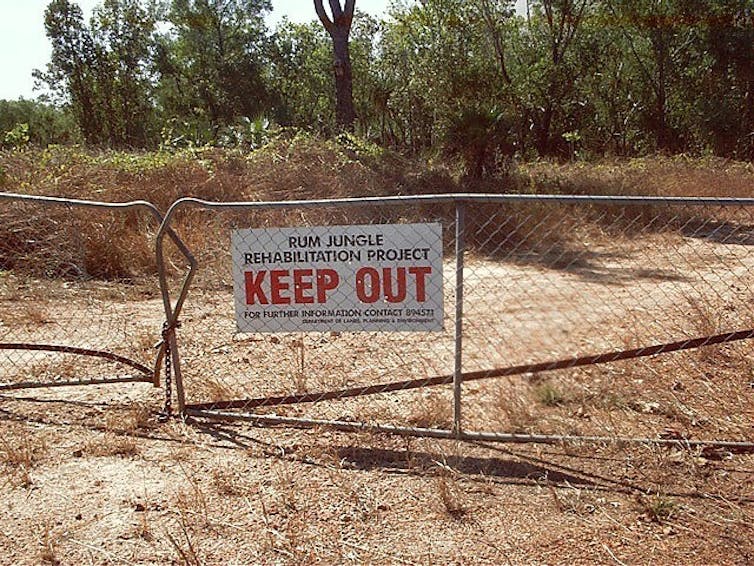
The former Mary Kathleen mine, also part of Rio Tinto’s corporate history, operated from 1958-63 and 1976-82.
Rehabilitation works were completed by 1986 and won national engineering awards for excellence. But by the late 1990s, acid seepage problems emerged from the tailings dam (where mining by-products are stored) and overlying grasses were absorbing toxic heavy metals, creating a risk for grazing cattle.
Rare earth metals are also present in these tailings, leading to the possibility the tailings will be reprocessed to fund the next round of rehabilitation. The site remains in limbo, despite its Instagram fame.
Both Rum Jungle and Mary Kathleen were rehabilitated to the standards of their day, but they have not withstood the test of time.
Australia’s biggest uranium mine, Ranger, is fast approaching the end of its operating life.
Rio Tinto is also the majority owner of Ranger. Despite Ranger’s recent losses, Rio has retained control and given Ranger hundreds of millions of dollars towards ensuring site operations and rehabilitation.
In recent years the cost of rehabilitation has soared from A$565 million in 2011 to A$897 million in 2019, over which time A$603 million has been spent on rehabilitation works.
Site rehabilitation is required to be complete by January 2026, with Rio Tinto and Ranger assuming 25 years of monitoring – although plans and funding for this are still being finalised.
The legal requirement is that no contaminants should cause environmental impacts for 10,000 years, and no other mine has ever faced such a hurdle.
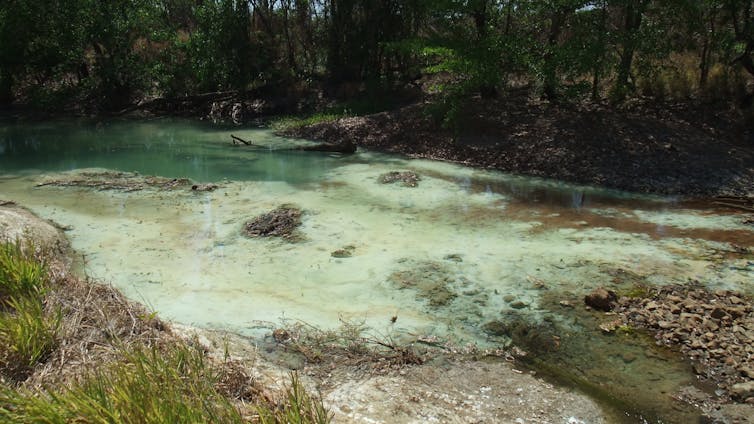
Recently, it emerged that Ranger had not agreed to continue its share of funding the scientific research required for the rehabilitation – an issue still unresolved. So despite promises of world’s best ever rehabilitation, concerns remain.
The Conversation contacted Rio Tinto to respond, and it referred us to Energy Resources Australia (ERA), which operates Ranger. An ERA spokesperson stated:
Since 1994, ERA has made an annual contribution to research into the environmental effects of uranium mining in the Alligator Rivers Region under an agreement with the Commonwealth. The agreement provides for a review of funding contributions at fixed periods or at either party’s request to acknowledge changes in Ranger operations.
ERA is required to cease processing in January 2021 in accordance with the expiration of its Authority to Operate under the Commonwealth Atomic Energy Act. Given the impending cessation in processing, ERA believes it is appropriate and reasonable to review the current research funding arrangements.
ERA has followed due process in this matter and welcomes the Commonwealth’s decision to support a process of mediation to resolve the issue.
No other former uranium mine in Australia can claim long-term rehabilitation success. Nabarlek, Radium Hill-Port Pirie, South Alligator Valley and other small mines all have issues such as erosion, weeds, remaining infrastructure, radiation hot-spots and/or water contamination. They all require ongoing surveillance.
Uranium Mining Is Set To Be Outcompeted
Australia’s uranium export revenue from 1977 to December A$2019 was A$29.4 billion. Lithium has now overtaken uranium in export revenue – from 2017 to 2019, lithium earned Australia two to three times our uranium exports.
Even if Olympic Dam expands (and especially if it stops extracting uranium in favour of tellurium, cobalt and rare earths also present), this trend is expected to increase in the coming years as Ranger closes and the world transitions to renewable energy and electric vehicles to help address climate change.
In response, the Minerals Council of Australia stated that lithium’s contribution to large-scale electricity storage is just beginning, arguing:
With the development of new nuclear technologies such as small modular and micro reactors, the prospects for the future of both uranium and lithium are positive and no one should be picking winners apart from the market.
Ultimately, uranium remains an element with immense potential for misuse - as seen with North Korea and other rogue nuclear states. Federal oversight of uranium mining must remain. After all, the price of peace is eternal vigilance.![]()
Gavin Mudd, Associate Professor of Environmental Engineering, RMIT University
This article is republished from The Conversation under a Creative Commons license. Read the original article.
Mr Morrison, you can cut 'green tape' without harming nature – but it'll take money and gumption
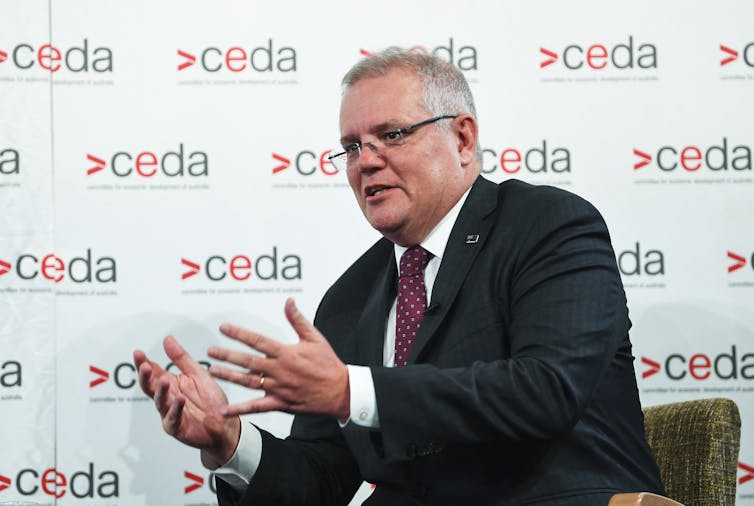
Prime Minister Scott Morrison this week announced environmental approvals for 15 major infrastructure projects will be fast-tracked to accelerate investment as Australia emerges from the COVID-19 lockdown.
Under the current system, proponents must seek both state and federal approvals for big developments. The new “single touch” approvals process will involve teams of state and federal officials assessing the projects jointly.
Read more: View from The Hill: 'Can do' Scott Morrison needs to take care in deregulating
This is by no means the first attempt by governments to streamline environmental approvals. Morrison says the latest push will be informed by a ten-year review of the Environmental Protection and Biodiversity (EPBC) Act, which has also been framed around cutting so-called “green tape” that slows developments. An interim report is due this month.
I was a federal environment official for 13 years, and from 2007 to 2012 was responsible for administering and reforming the Act. There are ways the laws can be streamlined without sacrificing the environment. But isolated from more comprehensive environmental reform, faster approval will bring significant environmental risk.
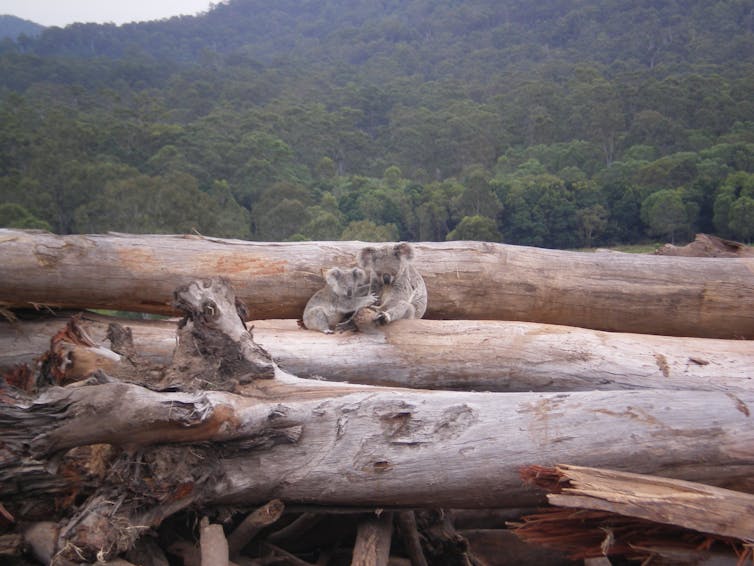
We’ve Been Here Before
The first national agreement to streamline environmental approvals dates back to 1990, and Bob Hawke’s “New Federalism” push to reduce overlap between Commonwealth and state environmental laws.
More recently, the Gillard government in 2012, at the urging of business interests, sought to strike bilateral agreements with the states to reduce duplication in environmental approvals. The push was abandoned when each state demanded different arrangements, making the proposed system too messy and complex.
In 2014 the Abbott government revived this “one-stop shop” approach, but the move was blocked by the Senate.
A Risky Business
Environment advocates naturally oppose moves to streamline environmental laws and approval processes. They argue the regime already fails to protect threatened species and biodiversity, and the bar should not be lowered further.
It’s true that while governments may claim faster approvals won’t erode environmental standards, there aren’t many hard-and-fast standards to maintain.
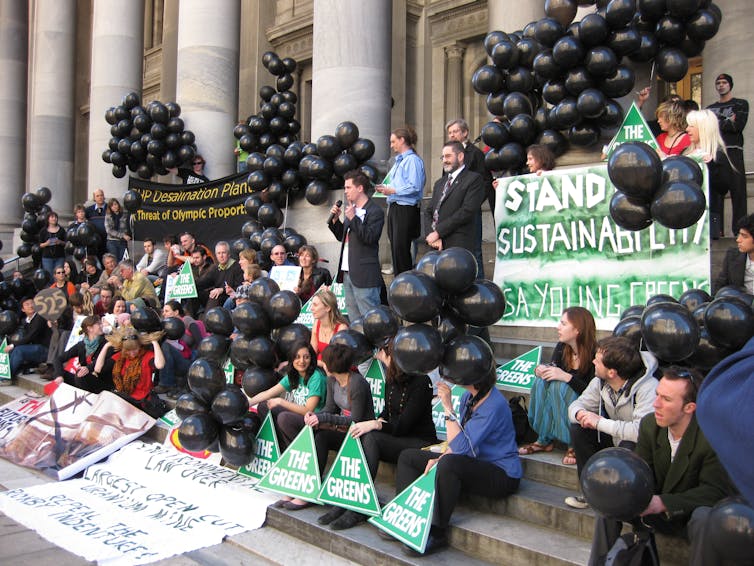
Instead, EPBC Act decisions mostly hinge on the minister’s conclusion that assessed environmental impacts are “not unacceptable”, provided certain conditions, such as minimising a project’s physical size, are met. But this is no standard at all, because such decisions are arbitrary and no “bottom line” for a project’s environmental performance is set.
As things stand, the closest thing to an on-ground environmental standard is the environmental offsets policy, which allows environmental damage from a project to be compensated for by environmental improvements elsewhere. But policies are not binding, there is no public register of approved offsets and little evidence of them being monitored and enforced.
Read more: Be worried when fossil fuel lobbyists support current environmental laws
The Act does include mechanisms for setting standards. These include “bioregional plans” intended to inform industry and decision-makers of the environmental values and objectives of a region, and how these should be met.
But since the Act commenced in 2000, just five such plans for marine areas have been developed, and none have been prepared for regions on land.
The Act also provides for recovery plans setting out the actions necessary to support listed threatened species. But as of 2018, fewer than half these species have recovery plans, and where they exist, the plans are often out of date and not specific enough.
Efficient Approvals Require Proper Resources
Morrison said his government wants to reduce Commonwealth assessment and approval times for major projects, from an average of 3.5 years to 21 months. But to do that, his government must stop starving its own regulatory systems of resources.
Between 2013 and 2019, the federal environment department’s budget was cut by 39.7%, according to an assessment by the Australian Conservtaion Foundation. So it’s little wonder approval processes slowed.
In November last year the Morrison government announced A$25 million to reduce unnecessary delays in environmental assessments, including the establishment of a major projects team. In effect, this was merely a reversal of previous funding cuts by this government and some of its predecessors.
What’s more, an efficient approvals process needs good information, yet this can be hard to come by.
The much-needed National Plan for Environmental Information was established in 2010 “to improve the quality and accessibility of Australian environmental information”. It would have reduced the need for fieldwork in environmental assessments. But in my view it was never properly resourced, and it has since been abolished.
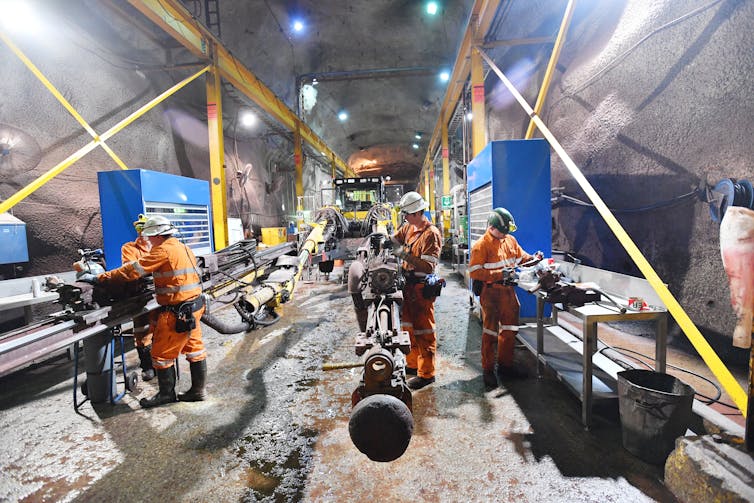
But Streamlining Could Work
There are ways the Commonwealth and states could cut environmental approval times without cutting corners.
The proposed joint assessment teams would have to be well-resourced. They would also have to be authorised to negotiate procedural or cultural obstacles to meeting both federal and state legal requirements.
When I was in the environment department, it was common for federal and state officials to complain their counterparts were not addressing the assessment and approval requirements of the other jurisdiction.
And if companies behind developments want faster approvals, they will have to provide information to officials in a timely fashion – something that doesn’t always happen now.
Read more: Environment laws have failed to tackle the extinction emergency. Here's the proof
Australia has learnt much during the pandemic – not only about cooperation between the Commonwealth and the states, but also between government and business. Success in this latest streamlining attempt will demand excellence in both.
The larger challenge is to speed up the process without lowering the environmental bar.
The federal government should commission independent monitoring and evaluation of the environmental outcomes of approvals under these new arrangements. In 2009 a Senate committee recommendedmore resources for monitoring and audits, but nothing has improved in the decade since.
Independent evaluation won’t win over the sceptics, but it might assuage their worst fears.![]()
Peter Burnett, Honorary Associate Professor, ANU College of Law, Australian National University
This article is republished from The Conversation under a Creative Commons license. Read the original article.
Energy giants want to thwart reforms that would help renewables and lower power bills
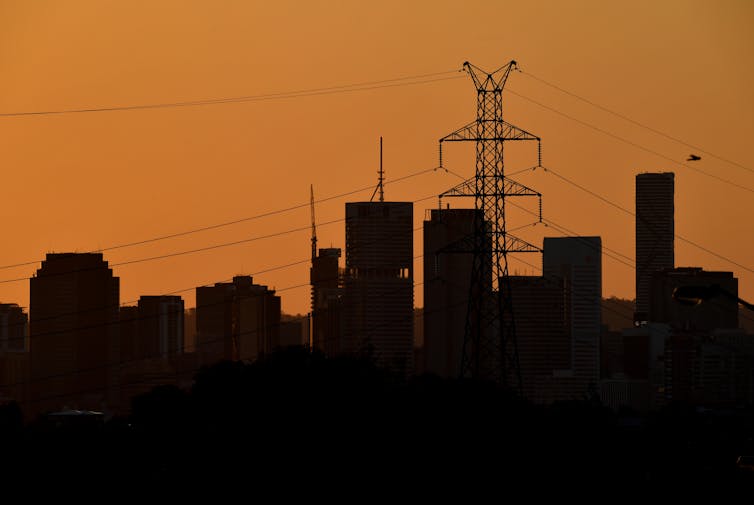
Australia’s energy market is outdated. It doesn’t encourage competition and that’s holding back the transition to renewable energy. Important reforms to modernise the market are on the way, but big energy companies are seeking to use the cover of COVID-19 to prevent the change.
This is bad for consumers, and for climate action. Reform would help create a modern grid designed around clean energy, pushing coal-fired generators to retire earlier. Over time, it would also bring down power costs for households and business.
Renewable energy is the cheapest form of new electricity. It’s far better for the environment than coal and gas, and can deliver reliable supplies when backed by batteries and other energy storage.
Instead of delaying reform, Australia should be advancing it.

What’s This All About?
Regulators and governments recognise the need to modernise the rules governing the National Electricity Market. That market, established in 1998, supplies all Australian jurisdictions except Western Australia and the Northern Territory.
Reliable electricity requires that supply and demand be kept in balance. This balance is primarily provided by a system known as the wholesale spot market. Every five minutes, electricity generators bid into the spot market, specifying how much energy they will provide at a certain price.
An entire redesign of the market rules is scheduled for 2025. This should make the market work efficiently and reliably as coal retires and is replaced by renewable energy.
In the meantime, one important rule change is due to start in July next year, known as “5-minute settlement”.
Read more: Matt Canavan says Australia doesn't subsidise the fossil fuel industry, an expert says it does
Currently, electricity is sold and sent out from generators in 5-minute blocks. But the actual price paid for this electricity in the wholesale market is averaged every 30 minutes. This means there are six dispatch periods, each with their own price, which are then averaged out when the market is settled.
This strange design has enabled big electricity generators to game the market. One method involves placing high bids in the first interval, then placing low or even negative bids in the remaining five intervals. This ensures that electricity from the big generators is purchased, but that they and all other generators receive an artificially high average price for the whole 30-minute period.
In 2017, the Australian Energy Market Commission (AEMC) decided to replace 30-minute settlement with 5-minute settlement.
The commission says the current system was adopted more than 20 years ago due to technological barriers which have since been overcome. It argues moving to 5-minute settlement would better reflect the value to consumers of fast-response technologies, such as batteries storing renewable energy and so-called “demand response” (a concept we’ll explain later).

According to the AEMC, the rule change would lead to lower wholesale costs, cutting electricity prices for consumers.
But on March 19 this year, the Australian Energy Council, which represents most coal-fired power stations and the big three electricity retailers, sought to delay the reform. It wrote to federal energy minister Angus Taylor and his state counterparts, arguing the pandemic means energy companies must focus on “critical supply and reliabilty” issues, rather than implementing the rule change.
But energy consumption has barely changed during the pandemic, the Australia Institute’s national energy emissions audit shows. So delaying the reform to deal with supply and reliability issues appears unjustified.
Despite this, the Australian Energy Market Operator has proposed delaying the change for a year. Our submission, endorsed by energy and technology leaders, opposes the delay.
Moves by regulators to delay another 16 market reforms due to COVID-19 also seem to be afoot.
Change Is Possible
Last week, one big rule change to the National Electricity Market did proceed as planned. It allows “demand response” energy trading from 2021.
Demand response involves reducing energy consumption during peaks in demand, such as during heatwaves. Basically, the rule means big energy users, such as smelters and manufacturing plants, could power down in these periods, and be paid for doing so.
Technology pioneers such as battery entrepreneur Simon Hackett and Atlassian chief Mike Cannon-Brookes have backed this change.
Australia has successfully used demand response to provide emergency electricity capacity and other benefits. But it’s never been unleashed in the wholesale energy market.
The rule change doesn’t involve smaller users such as households. But it’s a promising start that creates new competition for fossil fuel generators and allows energy users to help make the grid more reliable.
Read more: New demand-response energy rules sound good, but the devil is in the (hugely complicated) details
Political warfare over climate policy has held back Australia, and the electricity market, for more than a decade. But energy reform that encourages greater market competition can readily be supported by political conservatives.
The demand-response rule change is a clear example: it has been championed by Taylor and his predecessors Josh Frydenberg and Greg Hunt.
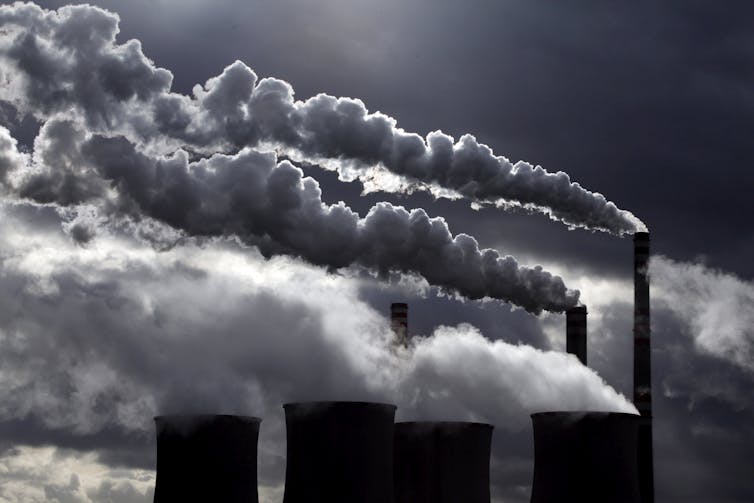
Getting Future-Ready
Once the health crisis is over and economic recovery has begun, Australia will need the economic and social benefits of electricity market reform even more than before.
Such reform “stimulus” would help ready the grid for the inevitable retirement of coal-fired power stations, such as Liddell in 2023.
It would also align with state government investments in renewable energy, and boost private investment in new generation (which has recently slumped) and large-scale batteries.
Electricity remains Australia’s highest-polluting sector. Around the world, electricity markets are planning the transition from high to low emissions.
Delaying reform in Australia would be a major setback on the path to our essential energy transition.
Richie Merzian, Climate & Energy Program Director at The Australia Institute, contributed to this piece.
Read more: Putting stimulus spending to the test: 4 ways a smart government can create jobs and cut emissions ![]()
Daniel J Cass, Research Affiliate, Sydney Business School, University of Sydney
This article is republished from The Conversation under a Creative Commons license. Read the original article.
People need to see the benefits from local renewable energy projects, and that means jobs
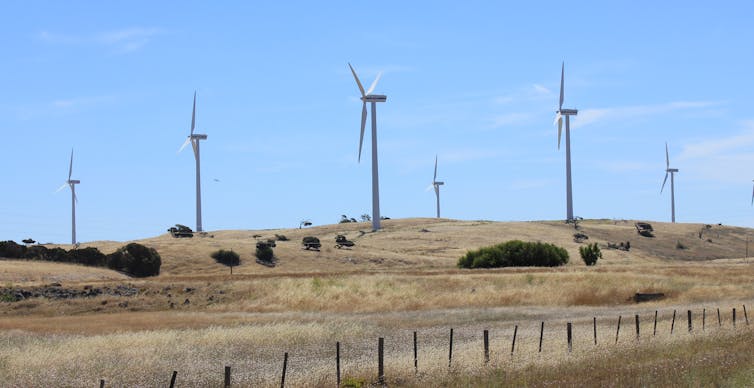
The Australian government’s investment roadmap for low-emissions technologies promises more taxpayers’ money to the gas industry but fails to deliver the policy needed for people to support a transition to renewable energy.
It ignores what academic experts, the CSIRO, the Australian Energy Market Operator, the Australian Industry Group and several premiers and energy ministers are all saying: renewable sources of energy are already cheaper than gas or coal generation, and wind and solar could provide up to 75% of Australia’s electricity by 2025. The technologies could also drive employment in a post-COVID renewables-led recovery, enabling Australia to “rebuild stronger and cleaner”.
Read more: Energy giants want to thwart reforms that would help renewables and lower power bills
But policymakers need to make sure the communities bearing the costs of the energy transition also share in its benefits.
Get Local People Involved
Our research on the social impacts of renewable energy shows a strong emphasis on sharing the benefits with the community and encouraging participation is essential for successful energy transitions.
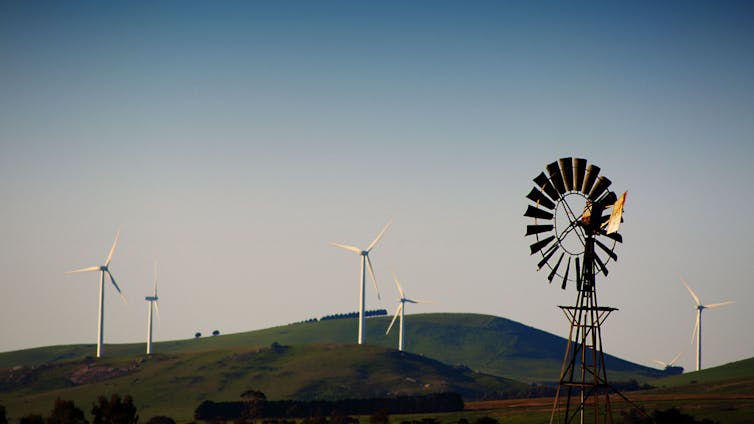
The bulk of well-paid, plentiful jobs in renewables come during manufacture and construction, but who benefits from those jobs can be an issue.
Mortlake, in south-west Victoria, is home to two wind farms that won tenders under the state’s Renewable Energy Auction Scheme.
The scheme is successful in making local content commitments, with regional supply chains and training in Geelong, Ballarat and Portland. Local content in this context refers to the Victorian Major Projects Skills Guarantee and the Local Jobs First policy. These government schemes are principally designed to encourage employment in Victoria.
While some construction workers have come from nearby areas, employment is mainly local to the state, not to people living in Mortlake. One of the locals described the experience to us as a “circus coming to town” – not jobs.
Commitments to Australian employment are a step in the right direction, but the term “local” should be used with caution.
The suppliers and tradespeople in a community earmarked for any renewable energy project may lack the specialist training and hence are less likely to get hired. Industry tendering processes still tend to favour large national or international contractors with established supply chains.
The wind industry in Mortlake has become a better listener to community concerns, partly due to lessons learnt from previous local opposition to proposed wind farms. The emphasis now is on local benefits and engagement.
For example, one of the wind farm developers agreed to put the transmission line underground following council lobbying.
Don’t Divide Communities
Renewable energy projects are often in direct competition with gas for the hearts and minds of communities.
Yet one study found there are many more potential jobs in renewables than in gas in north-west New South Wales.
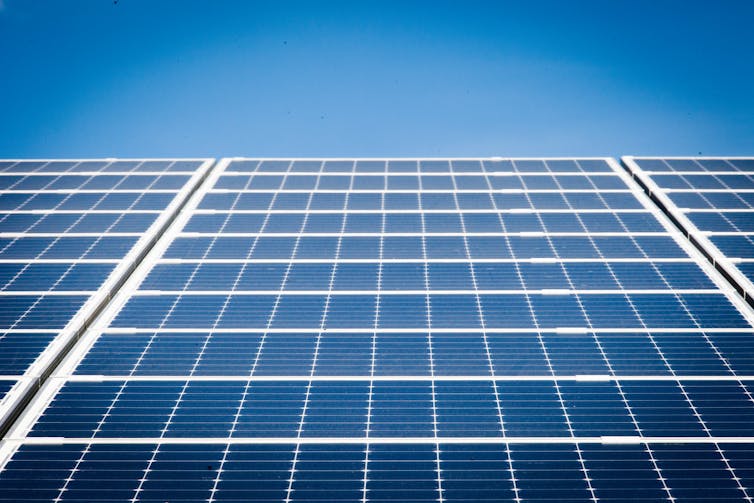
Narrabri is close to the NSW government’s New England Renewable Energy Zone. According to the AltEnergy database, there have been proposals dating from 2018 for at least six solar farms in the region (three each in Narrabri and Gunnedah).
Together these would produce about 600 megawatts of electricity. Most of the projects have undertaken community consultation and secured planning approvals. Only Gunnedah South, which has secured a power supply contract with Amazon, appears to be imminent, with 150 locally sourced jobs in the construction phase.
Locals we interviewed in Narrabri and Gunnedah in 2018 were sceptical that renewables could deliver lasting jobs. Clearly, there still needs to be evidence on the ground that the renewables industry can create local employment, whether directly or via related ventures and supply chains.
While few people knew of the numerous solar projects or could name the companies involved, everybody we spoke to knew of Santos and its proposal to drill the region for gas.
Santos says it will create “up to” 200 ongoing jobs from its operations. But this is contested and there are concerns about impacts of gas drilling on water and on agriculture.
Opposition to the gas project has been strong. In 2018 the CSIRO found no more than 43% of locals would “be OK with” the proposed gas operation.
Yet Santos has created a sophisticated operation to press its case. The gas giant has its own store in town and donates money to local organisations. As we found, its name is everywhere: on rugby jerseys, at the golf course, in the local newspaper.
Locals Miss Out On The Benefits
The real problem with getting acceptance of renewables lies in ownership and participation. If local communities miss out on economic benefits from corporate-owned renewables, their willingness to accept infrastructure, such as an ever-greater density of wind farms, declines.
Read more: Really Australia, it's not that hard: 10 reasons why renewable energy is the future
The clear lesson is that social legitimacy comes from local benefits. If people see little local benefit and have weak relationships with the energy companies, they are likely to focus on negatives such as disruption to views, ecology and land use.
Improving the quality and stability of jobs would be a good start. Supporting local ownership, making regulation more renewables-friendly and diversifying and democratising energy production would help build a lasting social base for the energy transition we have to have.![]()
Tom Morton, Associate Professor, Journalism, Stream Leader, Climate Justice Research Centre, University of Technology Sydney; James Goodman, Professor in Political Sociology, University of Technology Sydney; Jonathan Paul Marshall, Future Fellow, University of Technology Sydney; Katja Müller, Postdoctoral Researcher in Anthropology, Martin Luther University Halle-Wittenberg, and Riikka Heikkinen, PhD Candidate, University of Technology Sydney
This article is republished from The Conversation under a Creative Commons license. Read the original article.
Don't count your fish before they hatch: experts react to plans to release 2 million fish into the Murray Darling
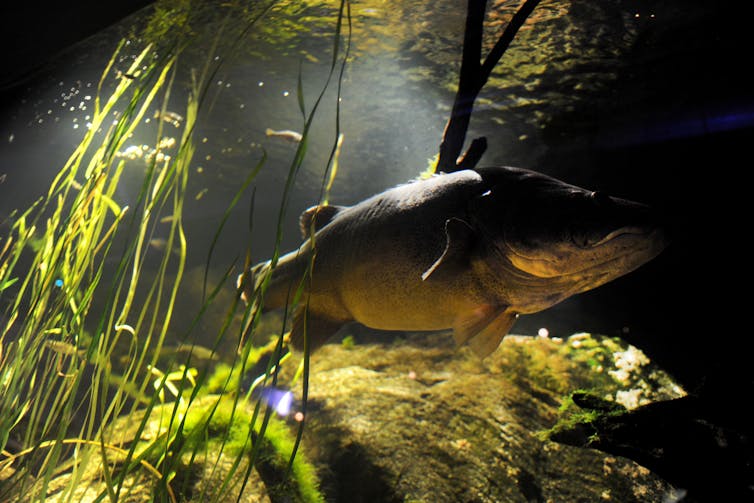
The New South Wales government plans to release two million native fish into rivers of the Murray-Darling Basin, in the largest breeding program of its kind in the state. But as the river system recovers from a string of mass fish deaths, caution is needed.
Having suitable breeding fish does not always guarantee millions of healthy offspring for restocking. And even if millions of young fish are released into the wild, increased fish populations in the long term are not assured.
For stocking to be successful, fish must be released into good quality water, with suitable habitat and lots of food. But these conditions have been quite rare in Murray Darling rivers over the past three years.
We research the impact of human activity on fish and aquatic systems and have studied many Australian fish restocking programs. So let’s take a closer look at the NSW government’s plans.
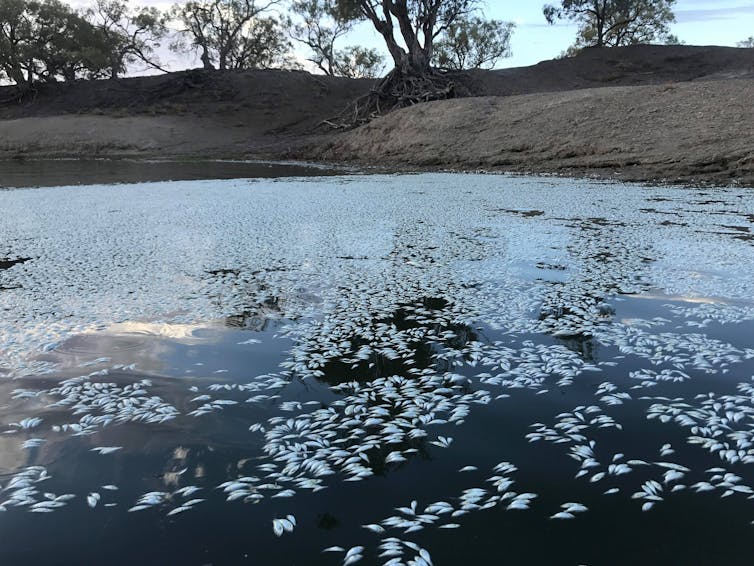
Success Stories
According to the Sydney Morning Herald, the NSW restocking program involves releasing juvenile Murray cod, golden perch and silver perch into the Darling River downstream of Brewarrina, in northwestern NSW.
Other areas including the Lachlan, Murrumbidgee, Macquarie and Murray Rivers will reportedly also be restocked. These species and regions were among the hardest hit by recent fish kills.
Fish restocking is used worldwide to boost species after events such as fish kills, help threatened species recover, and increase populations of recreational fishing species.
Since the 1970s in the Murray-Darling river system, millions of fish have been bred in government and private hatcheries in spring each year. Young fish, called fingerlings, are usually released in the following summer and autumn.
Read more: Australia, it's time to talk about our water emergency
There have been success stories. For example, the endangered trout cod was restocked into the Ovens and Murrumbidgee Rivers between 1997 and 2006. Prior to the restocking program, the species was locally extinct. It’s now re-established in the Murrumbidgee River and no longer requires stocking to maintain the population.
In response to fish kills in 2010, the Edward-Wakool river system was restocked to help fish recover when natural spawning was expected to be low. And the threatened Murray hardyhead is now increasing in numbers thanks to a successful stocking program in the Lower Darling.
After recent fish kills in the Murray Darling, breeding fish known as “broodstock” were rescued from the river and taken to government and private hatcheries. Eventually, it was expected the rescued fish and their offspring would restock the rivers.
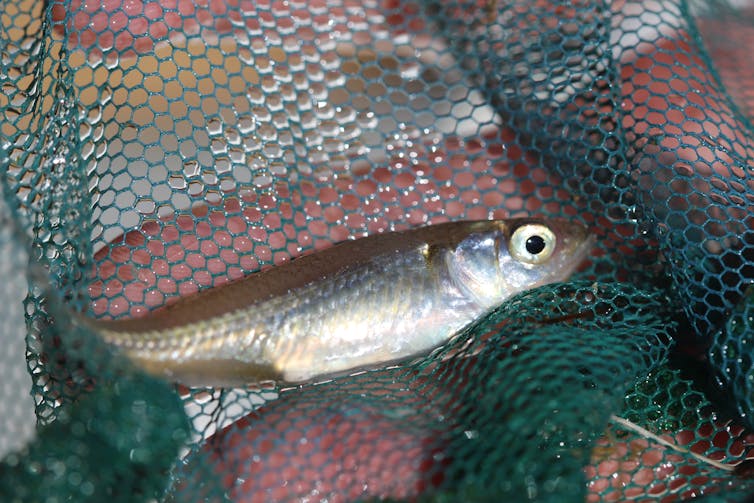
Words Of Caution
Fish hatchery managers rarely count their fish before they hatch. It’s quite a challenge to ensure adult fish develop viable eggs that are then fertilised at high rates.
Once hatched, larvae must be transported to ponds containing the right amount of plankton for food. The larvae must then avoid predatory birds, be kept free from disease, and grow at the right temperatures.
Read more: Last summer's fish carnage sparked public outrage. Here's what has happened since
When it comes to releasing the fish into the wild, careful decisions must be made about how many fish to release, where and when. Factors such as water temperature, pH and dissolved oxygen levels must be carefully assessed.
Introducing hatchery-reared fish into the wild does not always deliver dramatic improvements in fish numbers. Poor water quality, lack of food and slow adaptation to the wild can reduce survival rates.
In some parts of the Murray-Darling, restocking is likely to have slowed the decline in native fish numbers, although it has not stopped it altogether.
Address The Root Cause
Fish stocking decisions are sometimes motivated by economic reasons, such as boosting species sought by anglers who pay licence fees and support tourist industries. But stocking programs must also consider the underlying reasons for declining fish populations.
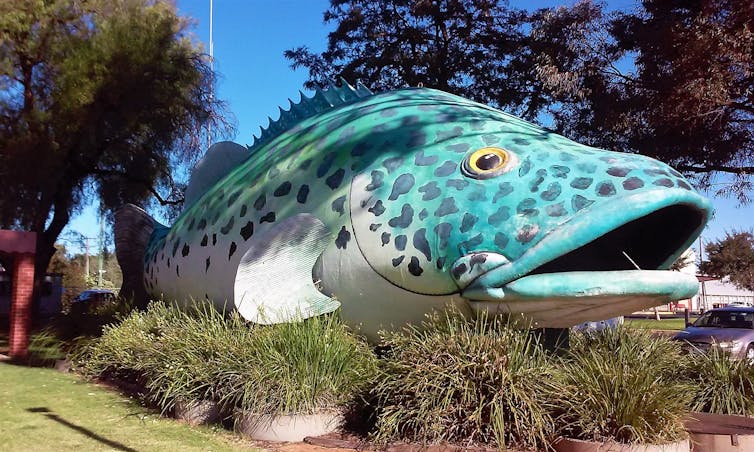
Aside from poor water quality, fish in the Murray Darling are threatened by being sucked into irrigation systems, cold water pollution from dams, dams and weirs blocking migration paths and invasive fish species. These factors must be addressed alongside restocking.
Fish should not be released into areas with unsuitable habitat or water quality. The Darling River fish kills were caused by low oxygen levels, associated with drought and water extraction. These conditions could rapidly return if we have another hot, dry summer.
Stocking rivers with young fish is only one step. They must then grow to adults and successfully breed. So the restocking program must consider the entire fish life cycle, and be coupled with good river management.
The Murray Darling Basin Authority’s Native Fish Recovery Strategy includes management actions such as improving fish passage, delivering environmental flows, improving habitat, controlling invasive species and fish harvest restrictions. Funding the strategy’s implementation is a key next step.
Looking Ahead
After recent rains, parts of the Murray Darling river system are now flowing for the first time in years. But some locals say the flows are only a trickle and more rain is urgently needed.
Higher than average rainfall is predicted between July and September. This will be needed for restocked fish to thrive. If the rain does not arrive, and other measures are not taken to improve the system’s health, then the restocking plans may be futile.
Lee Baumgartner, Professor of Fisheries and River Management, Institute for Land, Water, and Society, Charles Sturt University; Jamin Forbes, Freshwater Ecologist, Charles Sturt University, and Katie Doyle, Freshwater Ecologist, Charles Sturt University
This article is republished from The Conversation under a Creative Commons license. Read the original article.
The number of climate deniers in Australia is more than double the global average, new survey finds
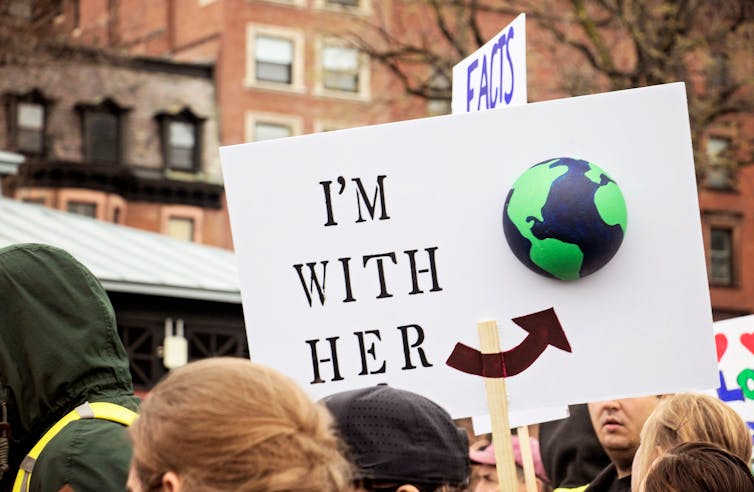
Australian news consumers are far more likely to believe climate change is “not at all” serious compared to news users in other countries. That’s according to new research that surveyed 2,131 Australians about their news consumption in relation to climate change.
The Digital News Report: Australia 2020 was conducted by the University of Canberra at the end of the severe bushfire season during January 17 and February 8, 2020.
Read more: Media 'impartiality' on climate change is ethically misguided and downright dangerous
It also found the level of climate change concern varies considerably depending on age, gender, education, place of residence, political orientation and the type of news consumed.
Young people are much more concerned than older generations, women are more concerned than men, and city-dwellers think it’s more serious than news consumers in regional and rural Australia.
15% Don’t Pay Attention To Climate Change News
More than half (58%) of respondents say they consider climate change to be a very or extremely serious problem, 21% consider it somewhat serious, 10% consider it to be not very and 8% not at all serious.
Out of the 40 countries in the survey, Australia’s 8% of “deniers” is more than double the global average of 3%. We’re beaten only by the US (12%) and Sweden (9%).
While most Australian news consumers think climate change is an extremely or very serious problem (58%), this is still lower than the global average of 69%. Only ten countries in the survey are less concerned than we are.
Strident Critics In Commercial Media
There’s a strong connection between the brands people use and whether they think climate change is serious.
More than one-third (35%) of people who listen to commercial AM radio (such as 2GB, 2UE, 3AW) or watch Sky News consider climate change to be “not at all” or “not very” serious, followed by Fox News consumers (32%).
This is perhaps not surprising when some of the most strident critics of climate change science can be found on commercial AM radio, Sky and Fox News.
Among online brands, those who have the highest concern about climate change are readers of The Conversation (94%) and The Guardian Australia (93%), which reflects that their audiences are more likely left-leaning and younger.
Read more: We want to learn about climate change from weather presenters, not politicians
More than half of Australians get their information about climate change from traditional news sources (TV 28%, online 17%, radio 5%, newspapers 4%).
However, 15% of Australians say they don’t pay any attention to news about climate change. This lack of interest is double the global average of 7%. Given climate change impacts everyone, this lack of engagement is troubling and reflects the difficulty in Australia to gain political momentum for action.
The Polarised Nature Of The Debate
The data show older generations are much less interested in news about climate change than news in general, and younger people are much more interested in news about climate change than other news.
Read more: Bushfires, bots and arson claims: Australia flung in the global disinformation spotlight
News consumers in regional Australia are also less likely to pay attention to news about climate change. One fifth (21%) of regional news consumers say they aren’t interested in climate change information compared to only 11% of their city counterparts.
Given this survey was conducted during the bushfire season that hit regional and rural Australia hardest, these findings appear surprising at first glance.
But it’s possible the results simply reflect the ageing nature of regional and rural communities and a tendency toward more conservative politics. The report shows 27% of regional and rural news consumers identify as right-wing compared to 23% of city news consumers.
And the data clearly reflect the polarised nature of the debate around climate change and the connection between political orientation, news brands and concern about the issue. It found right-wing news consumers are more likely to ignore news about climate change than left-wing, and they’re less likely to think reporting of the issue is accurate.
Regardless of political orientation, only 36% of news consumers think climate change reporting is accurate. This indicates low levels of trust in climate change reporting and is in stark contrast with trust in COVID-19 reporting, which was much higher at 53%.
The findings also point to a significant section of the community that simply don’t pay attention to the issue, despite the calamitous bushfires.
This presents a real challenge to news organisations. They must find ways of telling the climate change story to engage the 15% of people who aren’t interested, but are still feeling its effects.
19% Want News Confirming Their Worldview
Other key findings in the Digital News Report: Australia 2020 include:
the majority of Australian news consumers will miss their local news services if they shut down: 76% would miss their local newspaper, 79% local TV news, 81% local radio news service and 74% would miss local online news offerings
more than half (54%) of news consumers say they prefer impartial news, but 19% want news that confirms their worldview
two-thirds (62%) of news consumers say independent journalism is important for society to function properly
around half (54%) think journalists should report false statements from politicians and about one-quarter don’t
news consumption and news sharing have increased since 2019, but interest in news has declined
only 14% continue to pay for online news, but more are subscribing rather than making one-off donations
TV is still the main source of news for Australians but continues to fall.
The ‘COVID-Trust-Bump’
In many ways these findings, including those on climate change reporting, reflect wider trends. Our interest in general news has been falling, along with our trust.
This changed suddenly with COVID-19 when we saw a big rise in coverage specifically about the pandemic. Suddenly, the news was relevant to everyone, not just a few.
We suspect that key to the “COVID-trust-bump” was the news media adopting a more constructive approach to reporting on this issue. Much of the sensationalism, conflict and partisanship that drives news – particularly climate change news – was muted and instead important health information from authoritative sources guided the coverage.
This desire for impartial and independent news is reflected in the new report. The challenge is getting people to pay for it.![]()
Caroline Fisher, Co-author of the Digital News Report: Australia 2020, Deputy Director of the News and Media Research Centre, and Assistant Professor of Journalism, University of Canberra and Sora Park, Lead Author of Digital News Report: Australia 2020, Associate Dean of Research, Faculty of Arts & Design, University of Canberra
This article is republished from The Conversation under a Creative Commons license. Read the original article.
Pass the shiraz, please: how Australia's wine industry can adapt to climate change

Many Australians enjoy a glass of homegrown wine, and A$2.78 billion worth is exported each year. But hotter, drier conditions under climate change means there are big changes ahead for our wine producers.
As climate scientists and science communicators, we’ve been working closely with the wine industry to understand the changing conditions for producing quality wine in Australia.
Read more: We dug up Australian weather records back to 1838 and found snow is falling less often
We created a world-first atlas to help secure Australia’s wine future. Released today, Australia’s Wine Future: A Climate Atlas shows that all 71 wine regions in Australia must adapt to hotter conditions.
Cool wine regions such as Tasmania, for example, will become warmer. This means growers in that state now producing pinot noir and chardonnay may have to transition to varieties suited to warmer conditions, such as shiraz.
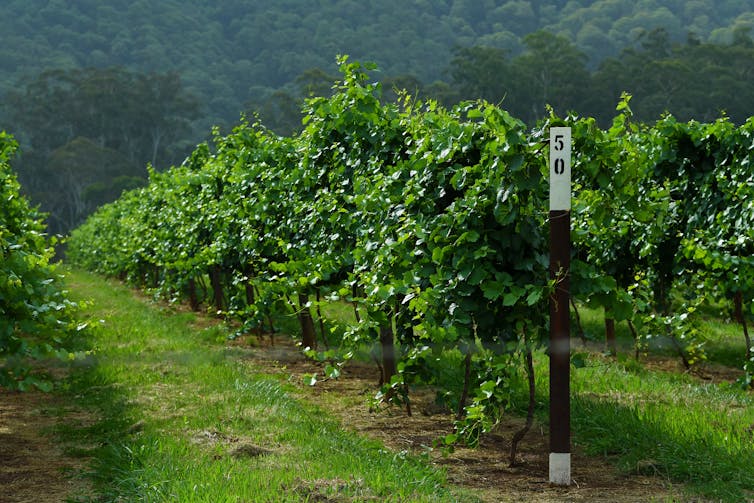
Hotter, Drier Conditions
Our research, commissioned by Wine Australia, is the culmination of four years of work. We used CSIRO’s regional climate model to give very localised information on heat and cold extremes, temperature, rainfall and evaporation over the next 80 years.
The research assumed a high carbon emissions scenario to 2100, in line with Earth’s current trajectory.
From 2020, the changes projected by the climate models are more influenced by climate change than natural variability.
Temperatures across all wine regions of Australia will increase by about 3℃ by 2100. Aridity, which takes into account rainfall and evaporation, is also projected to increase in most Australian wine regions. Less frost and more intense heatwaves are expected in many areas.
Read more: An El Niño hit this banana prawn fishery hard. Here’s what we can learn from their experience
By 2100, growing conditions on Tasmania’s east coast, for example, will look like those currently found in the Coonawarra region of South Australia – a hotter and drier region where very different wines are produced.
That means it may get harder to grow cool-climate styles of varieties such as chardonnay and pinot noir.
Some regions will experience more change than others. For example, the Alpine Valleys region on the western slopes of the Victorian Alps, and Pemberton in southwest Western Australia, will both become much drier and hotter, influencing the varietals that are most successfully grown.
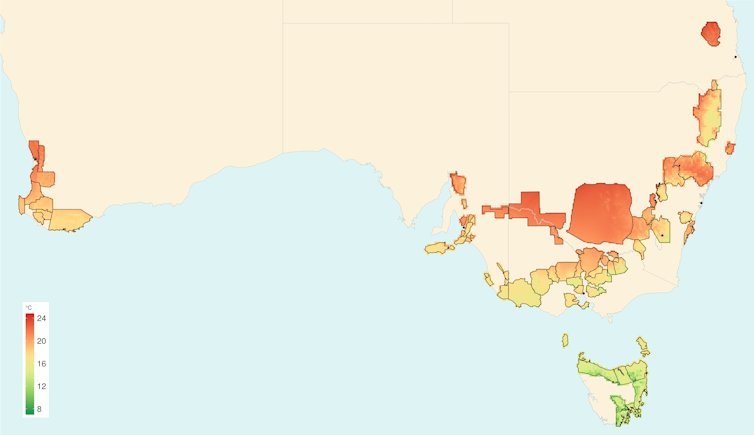
Other regions, such as the Hunter Valley in New South Wales, will not dry out as much. But a combination of humidity and higher temperatures will expose vineyard workers in those regions to heat risk on 40-60 days a year – most of summer – by 2100. That figure is currently about 10 days a year, up from 5 days historically.
Grape vines are very adaptable and can be grown in a variety of conditions, such as arid parts of southern Europe. So while adaptations will be needed, our projections indicate all of Australia’s current wine regions will be suitable for producing wine out to 2100.
Lessons For Change
Australia’s natural climate variability means wine growers are already adept at responding to change. And there is much scope to adapt to future climate change.
In some areas, this will mean planting vines at higher altitudes, or on south facing slopes, to avoid excessive heat. In future, many wine regions will also shift to growing different grape varieties. Viticultural practices may change, such as training vines so leaves shade grapes from heat. Growers may increase mulching to retain soil moisture, and areas that currently practice dryland farming may need to start irrigating.
The atlas enables climate information and adaptation decisions to be shared across regions. Growers can look to their peers in regions currently experiencing the conditions they will see in future, both in Australia and overseas, to learn how wines are produced there.

Industries Need Not Die On The Vine
Agriculture industries such as wine growing are not the only ones that need fine-scale climate information to manage their climate risk. Forestry, water management, electricity generation, insurance, tourism, emergency management authorities and Defence also need such climate modelling, specific to their operations, to better prepare for the future.
The world has already heated 1℃ above the pre-industrial average. Global temperatures will continue to rise for decades, even if goals under the Paris climate agreement are met.
If Earth’s temperature rise is kept below 1.5℃ or even 2℃ this century, many of the changes projected in the atlas could be minimised, or avoided altogether.
Australia’s wine industry contributes A$45 billion to our economy and supports about 163,000 jobs. Decisions taken now on climate resilience will dictate the future of this critical sector.
Gabi Mocatta, Research Fellow in Climate Change Communication, Climate Futures Programme, University of Tasmania; Rebecca Harris, Senior lecturer, Manager, Climate Futures Program, University of Tasmania, and Tomas Remenyi, Climate Research Fellow, Climate Futures Programme, University of Tasmania
This article is republished from The Conversation under a Creative Commons license. Read the original article.
How Fish Got Onto Land And Stayed There
June 17, 2020
Research on blennies, a family of fish that have repeatedly left the sea for land, suggests that being a ‘jack of all trades’ allows species to make the dramatic transition onto land but adapting into a ‘master of one’ allows them to stay there. The findings are published in the British Ecological Society journal Functional Ecology.

A group of Pacific leaping blennies out of the water on the foreshores of the island Guam. Credit Terry Ord
Researchers from University of New South Wales and the University of Minnesota pooled data on hundreds of species of blennies, a diverse family of fish where some are aquatic and others have left the water completely. They found that a flexible diet and behaviour were likely to be instrumental in the transition to land.
However, once out of the water, restrictions on the type of food available triggered major evolutionary changes, particularly to their teeth, as land dwelling blennies have become specialists in scraping algae and detritus from rocks.
Dr Terry Ord, lead author of the research, said: "The implications of our findings are that having a broad diet or being behaviourally flexible can help you move into a new habitat. But once there, this flexibility becomes eroded by natural selection."
“This presumably means those highly specialised species are less likely to be able to make further transitions, or cope with abrupt environment changes in their existing habitat.”
The scenario of fish colonising land has obvious parallels with the origin of all land vertebrates. “Fossils can give us important insights into how that transition might have unfolded, and the types of evolutionary adaptations it required or produced. But having a contemporary example of fish making similar ecological transitions can also help us understand the general challenges that are faced by fish out of the water” said Dr Ord.
Blennies are a remarkable family of fish with different species occupying strikingly different environments. Some are aquatic. Others spend time in and out of the water in the intertidal zone, an extreme environment with fluctuating water levels and pools that can rapidly change in temperature and oxygen levels.
Some species of blenny are terrestrial and spend almost their entire lives out of the water in the splash zone and must keep moist in order to breathe through their skin and gills. Despite these challenges, blennies have been incredibly successful in repeatedly making these dramatic transitions.
Because of this diversity, different blenny fish species represent clearly defined stages of the invasion process between two completely different environments. This makes them a unique group of animals to study.
Dr Ord explained the origin of the study with his co-author Dr Peter Hundt: “We both had extensive data collected on many different species of blenny from across the world. Peter had detailed information on diet and teeth morphology, while I had lots of data on behaviour and frequency of different species emerging from water for brief or extended periods on land.
“We threw a set of complex evolutionary statistical models at this combined data and we were able to reveal the sequence of events that likely allowed aquatic marine fishes to ultimately evolve into fishes that could leave water and then colonise land. Our study also showed how those species on land adaptively changed to better suit the specialised diet needed to survive on land.”
The authors caution that although the observational data suggests a flexible diet and behaviour allows a transition to new environments to occur, it cannot confirm causality. “Ideally we would perform some type of experimental investigation to try to establish casualty. What this experimental study might be is hard to imagine at this stage, but we’re working on it.” said Dr Ord.
The authors are also looking to further investigate how the invasion of land has impacted other aspects of blenny fish behaviour, ecology and bodies. “Terrestrial blennies are really agile out of water, and I suspect they’ve adapted their body shape to allow them to hop about the rocks so freely. Which in turn implies they might not be able to go back to the water” said Dr Ord, “It would also be exciting to know how their sensory systems might have adapted out of the water as well, given vision and smell would probably work quite differently in these environments.”
You can read the research article for free (for a limited time) here: https://besjournals.onlinelibrary.wiley.com/doi/10.1111/1365-2435.13600
Antarctic Sea Ice Loss: New Study
June 17, 2020
Scientists have discovered that summer sea ice in the Weddell Sea area of Antarctica has decreased by one million square kilometres – an area twice the size of Spain – in the last five years, with implications for the marine ecosystem. The findings are published this month (June 2020) in the journal Geophysical Research Letters.
Sea ice surrounding Antarctica provides an important habitat for many species including penguins and seals, which rely on it to access food and to breed.
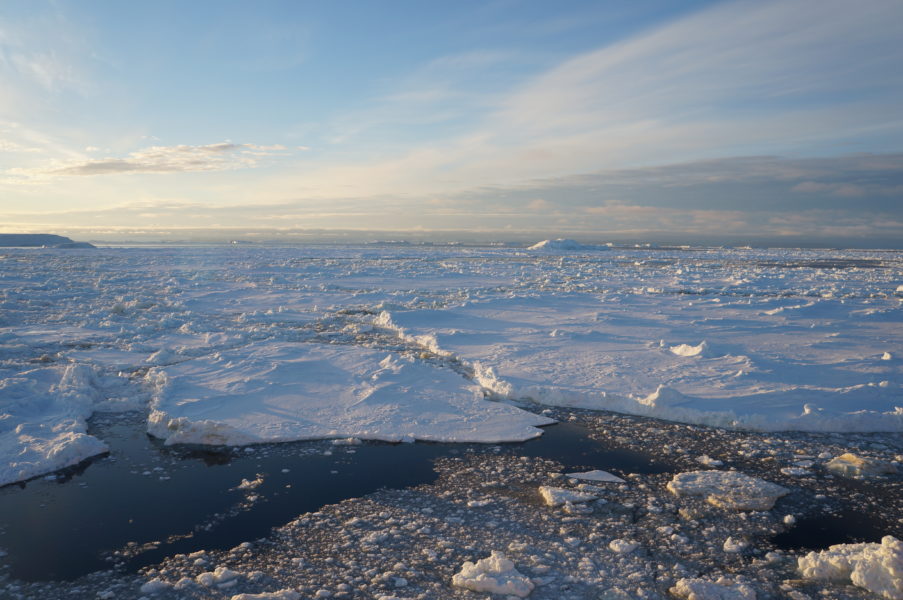
Sea ice in the Weddell Sea has reduced by one third over the last five years. Photo credit_Susie Grant
An international team of researchers studied satellite records of sea ice extent and weather analyses starting in the late 1970s to understand why summer sea ice in the Weddell Sea area of Antarctica has reduced by a third over the last five years. They found that ice loss occurred due to a series of severe storms in the Antarctic summer of 2016/17, along with the re-appearance of an area of open water in the middle of the ‘pack ice’ (known as a polynya), which had not occurred since the mid-1970s.
Lead author Professor John Turner, a climate scientist at British Antarctic Survey, says:
“Antarctic sea ice continues to surprise us. In contrast to the Arctic, sea ice around the Antarctic had been increasing in extent since the 1970s, but then rapidly decreased to record low levels, with the greatest decline in the Weddell Sea. In summer, this area now has a third less sea ice, which will have implications for ocean circulation and the marine wildlife of the region that depend on it for their survival.”
The ocean around Antarctica freezes and doubles the size of the continent in the austral winter, with the sea ice extent reaching over 18 million square kilometres by late September. Through the spring and summer, the sea ice almost completely melts in most parts of the Antarctic, with only the Weddell Sea retaining a significant amount of sea ice.
There are few storms around the Antarctic in the austral summer, but in December 2016, a number of intense and unseasonal storms developed in the Weddell Sea and drew warm air towards the Antarctic, melting a large amount of sea ice. The ice-free ocean absorbed energy from the Sun and then created a warm ocean temperature anomaly that still persists today.
The winter of 2016 also saw the development of a polynya in the Weddell Sea, a large area of open water within the sea ice, which also contributed to the overall decline in sea ice extent. This polynya was created by the strong winds associated with the storms and unprecedented warm ocean conditions.
This recent rapid sea ice loss is affecting both the Weddell Sea ecosystem and the wider Antarctic wildlife/plants and animals. Many species, ranging from tiny ice algae and shrimp-like crustaceans called krill to seabirds, seals and whales, are highly adapted to the presence of sea ice. If the drastic changes observed continue, they will have repercussions throughout the food chain, from affecting nutrients to the reduction of essential habitat for breeding and feeding for vast numbers of animals, such as ice seals and some species of penguins.
Author and ecologist Professor Eugene Murphy from British Antarctic Survey says:
“The dramatic decline in sea ice observed in the Weddell Sea is likely to have significant impacts on the way the entire marine ecosystem functions. Understanding these wider consequences is of paramount importance, especially if the decline in ice extent continues.”
Because of the large year-to-year variability in Antarctic sea ice extent the scientists cannot be sure if the ice in the Weddell Sea will in the short-term recover to the values seen before 2016 or whether they are seeing the start of the expected long-term decline of sea ice.
Researchers on this study were from British Antarctic Survey, the Indian National Centre for Polar and Ocean Research, Nanjing University, China and Victoria University of Wellington, New Zealand.
Recent Decrease of Summer Sea Ice in the Weddell Sea, Antarctica by John Turner, Maria Vittoria Guarino, Jack Arnatt, Babula Jena, Gareth J. Marshall, Tony Phillips, C. C. Bajish, Kyle Clem, Zhaomin Wang, Tom Andersson, Eugene J. Murphy and Rachel Cavanagh is published in the journal Geophysical Research Letters here
Please Help Sydney Wildlife Rescue: Donate Your Cans And Bottles And Nominate SW As Recipient
You can Help Sydney Wildlife help Wildlife. Sydney Wildlife Rescue is now listed as a charity partner on the return and earn machines in these locations:
- Pittwater RSL Mona Vale
- Northern Beaches Indoor Sports Centre NBISC Warriewood
- Woolworths Balgowlah
- Belrose Super centre
- Coles Manly Vale
- Westfield Warringah Mall
- Strathfield Council Carpark
- Paddy's Markets Flemington Homebush West
- Woolworths Homebush West
- Bondi Campbell pde behind Beach Pavilion
- Westfield Bondi Junction car park level 2 eastern end Woolworths side under ramp
- UNSW Kensington
- Enviro Pak McEvoy street Alexandria.
Every bottle, can, or eligible container that is returned could be 10c donated to Sydney Wildlife.
Every item returned will make a difference by removing these items from landfill and raising funds for our 100% volunteer wildlife carers. All funds raised go to support wildlife.
It is easy to DONATE, just feed the items into the machine select DONATE and choose Sydney Wildlife Rescue. The SW initiative runs until August 23rd.
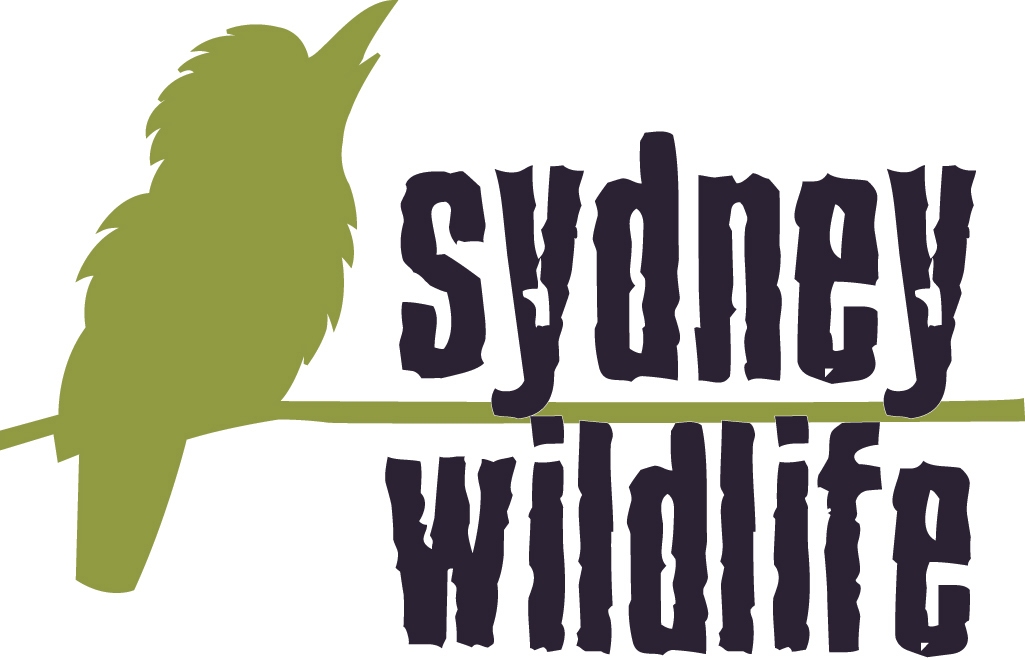
ORRCA Art Comp. 2020 And ORRCA Census Day 2020
ORRCA stands for the Organisation for the Rescue and Research of Cetaceans in Australia. Put simply, our primary focus is the rescue, preservation, conservation and welfare of Whales, Dolphins, Seals and Dugongs in Australian waters.
ORRCA operates a 24/7 Rescue Hotline for the public to report any injured or stranded whales, dolphins, seals and dugongs. Simply call 02 9415 3333.
We are the only volunteer wildlife rehabilitation group in New South Wales licensed to be involved with marine mammal rescue, rehabilitation and release. Our members come from all walks of life, age groups and nationalities.
ORRCA offers the community one of the most experienced and successful whale, dolphin, seal and dugong rescue teams in Australia. We are also proud that today, we have rescue trained teams in Western Australia and Queensland available to support local authorities should a marine mammal incident arise.
All members within ORRCA are volunteers
We operate as a non-profit organisation and have charity status.
It is because of the generosity of the public providing donations, and the love and passion of people wanting to get involved and learn about these amazing animals, that ORRCA exists on its own two flippers today.
Through our ever growing membership base of valued and dedicated volunteers and our highly commended rescue training workshops coupled with the strength and dedication of the Committee, ORRCA has achieved extraordinary things over the past 34 years.
ORRCA operates a 24/7 Rescue Hotline for the public to report any injured or stranded whales, dolphins, seals and dugongs. Simply call 02 9415 3333.
Visit: http://www.orrca.org.au/

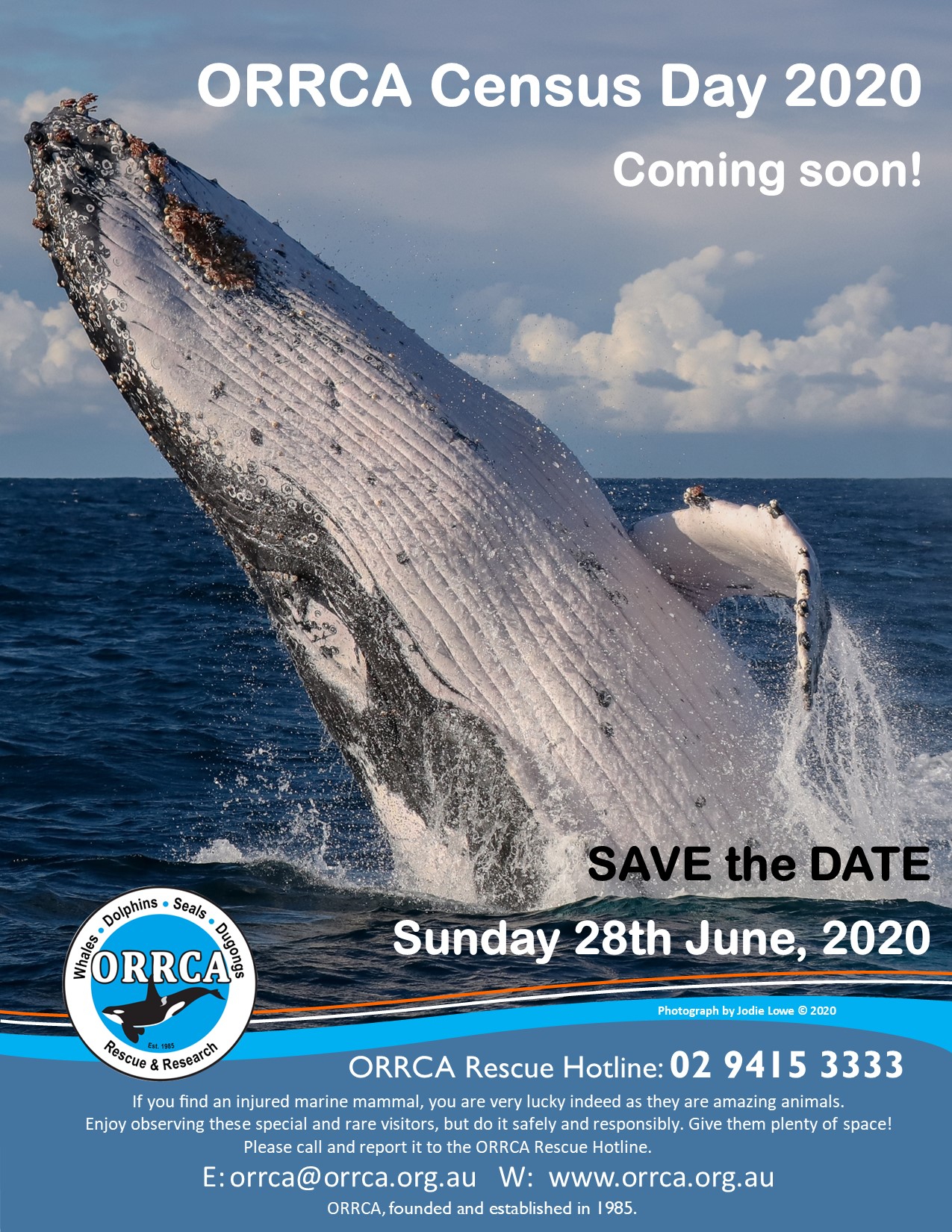
Rat Poisons Are Killing Our Wildlife: Alternatives
BirdLife Australia is currently running a campaign highlighting the devastation being caused by poison to our wildlife. Rodentcides are an acknowledged but under-researched source of threat to many Aussie birds. If you missed BirdLife's rodenticide talk but would like to know more, share data and comment on the use of rodenticides in Australia please visit: https://www.actforbirds.org/ratpoison
Owls, kites and other birds of prey are dying from eating rats and mice that have ingested Second Generation rodent poisons. These household products – including Talon, Fast Action RatSak and The Big Cheese Fast Action brand rat and mice bait – have been banned from general public sale in the US, Canada and EU, but are available from supermarkets throughout Australia.
Australia is reviewing the use of these dangerous chemicals right now and you can make a submission to help get them off supermarket shelves and make sure only licenced operators can use them.
There are alternatives for household rodent control – find out more about the impacts of rat poison on our birds of prey and what you can do at the link above and by reading the information below.
Let’s get rat poison out of bird food chains.
The Australian Pesticides and Veterinary Medicines Authority (APVMA) – is currently asking Australians for their views on how rodent poisons are regulated.
Have your say by making a submission here.
Powerful Owl at Clareville - photo by Paul Wheeler
Pesticides that are designed to control pests such as mice and rats cane also kill our wildlife through either primary or secondary poisoning. Insecticides include pesticides (substances used to kill insects), rodenticides (substances used to kill rodents, such as rat poison), molluscicides (substances used to kill molluscs, such as snail baits), and herbicides (substances used to kill weeds).
Primary poisoning occurs when an animal ingests a pesticide directly – for example, a brushtail possum or antechinus eating rat bait. Secondary poisoning occurs when an animal eats another animal that has itself ingested a pesticide – for example, a greater sooty owl eating a rate that has been poisoned or an antechinus that had eaten rat bait.
Rodenticides are the most common and harmful pesticides to Australian wildlife. Though no comprehensive monitoring of non-target exposure of rodenticides has been conducted, numerous studies have documented the harm rodenticides do to native animals. In 2018, an Australian study found that anticoagulant rodenticides in particular are implicated in non-target wildlife poisoning in Australia, and warned Australia’s usage patterns and lax regulations “may increase the risk of non-target poisoning”.
Most rodenticides work by disrupting the normal coagulation (blood clotting) process, and are classified as either “first generation” / “multiple dose” or “second generation” / “single dose”, depending on how many doses are required for the poison to be lethal.
These anticoagulant rodenticides cause victims of anticoagulant rodenticides to suffer greatly before dying, as they work by inhibiting Vitamin K in the body, therefore disrupting the normal coagulation process. This results in poisoned animals suffering from uncontrolled bleeding or haemorrhaging, either spontaneously or from cuts or scratches. In the case of internally haemorrhaging, which is difficult to spot, the only sign of poisoning is that the animal is weak, or (occasionally) bleeding from the nose or mouth. Affected wildlife are also more likely to crash into structures and vehicles, and be killed by predators.
An animal has to eat a first generation rodenticide (e.g. warfarin, pindone, chlorophaninone, diphacinone) more than once in order to obtain a lethal dose. For this reason, second generation rodenticides (e.g. difenacoum, brodifacoum, bromadiolone and difethialone) are the most commonly used rodenticides. Second generation rodenticides only require a single dose to be consumed in order to be lethal, yet kill the animal slowly, meaning the animal keeps coming back. This results in the animal consuming many times more poison than a single lethal dose over the multiple days it takes them to die, during which time they are easy but lethal prey to predators. This is why second generation poisons tend to be much more acutely toxic to non-target wildlife, as they are much more likely to bioaccumulate and biomagnify, and clear very slowly from the body.
Species most at risk from poisons
Small Mammals
Small mammals including possums and bandicoots often consume poisons such as snail bait, or rat bait that has been laid out to attract and kill rats, mice, and rabbits. Poisons such as pindone are often added to oats or carrots, and lead to a slow, painful death of internal bleeding. Australian possums often consume rat bait such as warfarin, which causes extensive internal bleeding, usually resulting in death.
There is a very poor chance of survival. Possums are also known to consume slug bait, which results in a prolonged painful death mainly from neurological effects. There is no treatment.
Small mammals can also be poisoned by insecticides. Possums, for example, can ingest these poisons when consuming fruit from a tree that has been sprayed with insecticide. Rescued by a WIRES carer, the brushtail possum joey pictured below was suffering from suspected insecticide poisoning. Though coughing up blood, luckily the joey did not ingest a lethal dose as he survived in care and was later released.
Large Mammals
Despite their size, large mammals including wallabies, kangaroos and wombats can also fall victim to pesticide poisoning. Wallabies and kangaroos have been known to suffer from rodenticide poisoning, while poisons often ingested by wombats include rat bait from farm sheds, and sodium fluroacetate (1080) laid out to kill pests such as cats and foxes.
Australian mammals are also impacted by the use of insecticides. DDT, although a banned substance, has been reported as killing marsupials.
Birds
Birds have a high metabolic rate and therefore succumb quickly to poisons. Australian birds of prey – owls (such as the southern boobook) and diurnal raptors (such as kestrels) – can be killed by internal bleeding when they eat rodents that have ingested rat bait. A 2018 Western Australian study determined that 73% of southern boobook owls found dead or were found to have anticoagulant rodenticides in their systems, and that raptors with larger home ranges and more mammal-based diets may be at a greater risk of anticoagulant rodenticide exposure.
Insectivorous birds will often eat insects sprayed with insecticides, and a few different species of birds may be affected at the same time. Unfortunately little can be done and death most often results.
Organophosphates are the most widely used insecticide in Australia. Birds are very susceptible to organophosphates, which are nerve toxins that damage the nervous system, with poisoning occurring through the skin, inhalation, and ingestion. Organophosphates can cause secondary poisoning in wild birds which ingest sprayed insects. Often various species of insectivorous birds are affected at the same time as they come down to eat the dying insects. After a bird is poisoned, death usually occurs rapidly. Raptors have also been deliberately or inadvertently poisoned when organophosphates have been applied to a carcass to poison crows.
Organochlorine pesticides (OCPs) are persistent, bio-accumulative pesticides that include DDT, dieldrin, heptachlor and chlordane. OPC’s have been used extensively in the agriculture industry since the 1940s. Some of the more common product names include Hortico Dieldrin Dust, Shell Dieldrex and Yates Garden Dust. Although no OCP’s are currently registered for use in the home environment in Australia, many of these products still remain in use on farms, in business premises and households. OCP poisons remain highly toxic in the environment for many years impacting on humans, animals, birds and especially aquatic life. They can have serious short-term and long-term impacts at low concentrations. In addition, non-lethal effects such as immune system and reproductive damage of some of these pesticides may also be significant. Birds are particularly sensitive to these pesticides, and there have even been occasions where the deliberate poisoning of birds has occurred. Tawny frogmouths are most often poisoned with OCP’s. The poisons are stored in fat deposits and gradually increase over time. At times of food scarcity, or during any stressful period, such as breeding season or any changes to their environment, the fat stores are metabolised, and with it, the poison load in their blood streams reaches acute levels, causing death.
Although herbicides, or weed killers, are designed to kill plants, some are toxic to birds. Common herbicide glyphosate (Roundup) will cause severe eye irritation in birds if they come into contact with the spray. Herbicides also have the impact of removing food plants that birds, or their insect food supply, rely on. Birds can also readily fall victim to snail baits, either via primary or secondary poisoning.
Reptiles and Amphibians
As vertebrate species, reptiles and amphibians are also at risk of pesticides. Though less is known about the effects of pesticides on reptiles and amphibians, these animals have been known to fall victim to pesticide poisoning. Blue-tongue lizards, for example, often consume rat bait and die of internal bleeding. A 2018 Australian study also found that reptiles may be important vectors (transporters) of rodenticides in Australia.
How to keep pests away and keep wildlife safe
Remember, pesticides are formulated to be tasty and alluring to the target species, but other species find them enticing, too. It is safest for wildlife, pets and people for us to not use any pesticides, and prevent or deter the presence of pests practically, rather than attempt to eliminate them chemically.
Tips to prevent and deter wildlife deaths from poisoning:
- Deter rats and mice around your property by simply cleaning up; removing rubbish, keeping animal feed well contained and indoors, picking up fallen fruits and vegetation, and using chicken feeders removes potential food sources.
- Seal up holes and in your walls and roof to reduce the amount of rodent-friendly habitat in your house.
- Replace palms with native trees; palm trees are a favourite hideout for black rats, while native trees provide ideal habitat for native predators like owls and hawks which help to control rodent populations.
- Set traps with care in a safe, covered spot, away from the reach of children, pets and wildlife. Two of the most effective yet safe baits are peanut butter and pumpkin seeds.
- To control slugs, terracotta or ceramic plant pots can be placed upside down in the garden or aviary. Slugs and snails will seek the dark, damp area this creates, and can be collected daily. They can then be drowned in a jar of soapy water. You can also sink a jar or dish into the soil and fill it with beer. The slugs are attracted to the yeast in the beer, fall in and then drown.
If turning to pesticides as a last resort:
- Use only animal-safe slug baits.
- Place tamper-proof bait stations out of reach of wildlife.
- Avoid using loose whether pellets or poison grain, present the highest risk, the latter being particularly attractive to seed-eating birds and to many small mammal species.
- Read the label and use as instructed.
- Avoid products containing second generation products difenacoum, brodifacoum, bromadiolone and difethialone, which are long-lasting and much more likely to unintentionally poison wildlife via secondary poisoning.
- Cover individual fruits when spraying fruit trees with insecticides.
Poisons kill dogs too
Because of their poisonous nature, pesticides pose a risk to animals and people alike, including pets and children. Roaming pets like cats and dogs are most at risk of being poisoned, with one 2016 study at the Norwegian University of Life Sciences finding that one in five dogs had rat poison in its body, and a 2011 study by the Humane Society in the United States finding that 74% of their pet poisoning cases are due to second-generation anticoagulants such as rat baits.
It is best to avoid the use of all pesticides, or otherwise use them sparingly, carefully and only after researching each poison and its correct usage. Always supervise pets and children, keep poisons locked out of their reach, and be vigilant in public spaces where pesticides may have accumulated, e.g. poisons can accumulate in streams or puddles where herbicides have recently been sprayed.
If you suspect your pet has been poisoned, seek veterinary help immediately.
If you suspect your child or another adult has been poisoned, do not induce vomiting and call the NSW Poisons Information Centre on 13 11 26 for 24/7 medical advice, Australia-wide.
References
Lohr, M. T. & Davis, R. A. 2018, Anticoagulant rodenticide use, non-target impacts and regulation: A case study from Australia, Science of The Total Environment, vol. 634, pp. 1372-1384.
Lohr, M. T. 2018, Anticoagulant rodenticide exposure in an Australian predatory bird increases with proximity to developed habitat, Science of The Total Environment, Volume 643, pp.134-144.
Lohr, M. T. 2018, Anticoagulant Rodenticides: Implications for Wildlife Rehabilitation, conference paper, Australian Wildlife Rehabiliation Conference, awrc.org.au
Olerud, S., Pedersen, J. & Kull, E. P. 2009, Prevalence of superwarfarins in dogs – a survey of background levels in liver samples of autopsied dogs. Norwegian University of Life Sciences, Faculty of Veterinary Medicine and Life Sciences, Department of Sports and Family Animal Medicine, Section for Small Animal Diseases.
Healthy Wildlife, Healthy Lives, 2017, Rodenticides and Wildlife, healthywildlife.com.au
Society for the Preservation of Raptors Inc. 2019, Raptor Fact Sheet: Eliminate Rats and Mice, Not Wildlife!, raptor.org.au/factsheetpests.pdf
W.I.R.E.S. Poisons and baits don't just kill rats.
.jpg?timestamp=1590728675788)
Barking Owl (Ninox connivens connivens)- photo by Julie Edgley - this nocturnal animal will eat mice and so become a victim of poisons through them
Echidna Season
Echidna season has begun. As cooler days approach, our beautiful echidnas are more active during the days as they come out to forage for food and find a mate. This sadly results in a HIGH number of vehicle hits.
What to do if you find an Echidna on the road?
- Safely remove the Echidna off the road (providing its safe to do so).
- Call Sydney Wildlife or WIRES
- Search the surrounding area for a puggle (baby echidna). The impact from a vehicle incident can cause a puggle to roll long distances from mum, so please search for these babies, they can look like a pinky-grey clump of clay
What to do if you find an echidna in your yard?
- Leave the Echidna alone, remove the threat (usually a family pet) and let the Echidna move away in it's own time. It will move along when it doesn't feel threatened.
If you find an injured echidna or one in an undesirable location, please call Sydney Wildlife on 9413 4300 for advice.
www.sydneywildlife.org.au
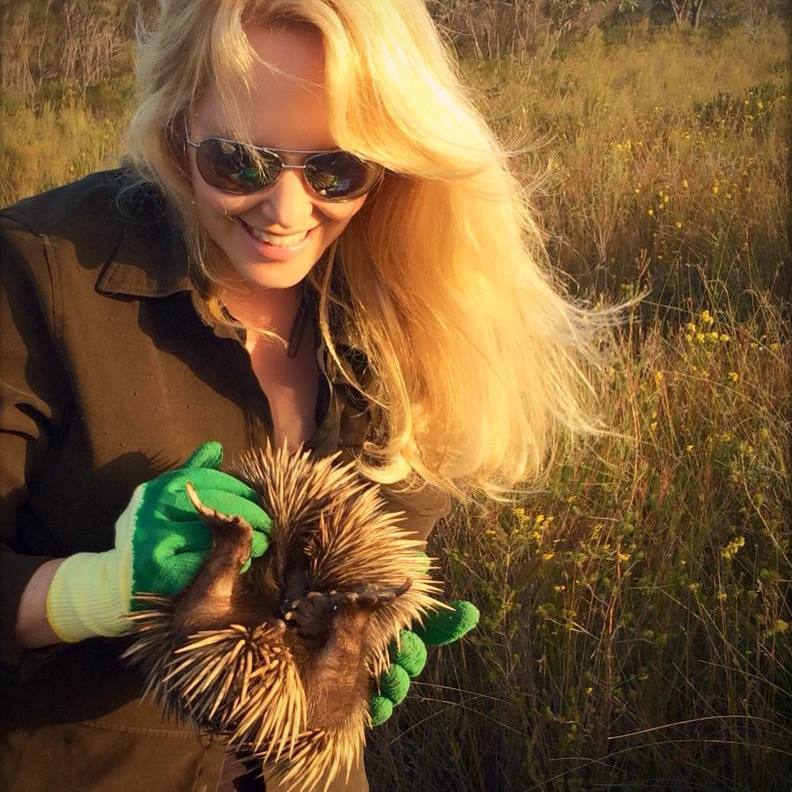
Lynleigh Greig, Sydney Wildlife, with a rescued echidna being returned to its home
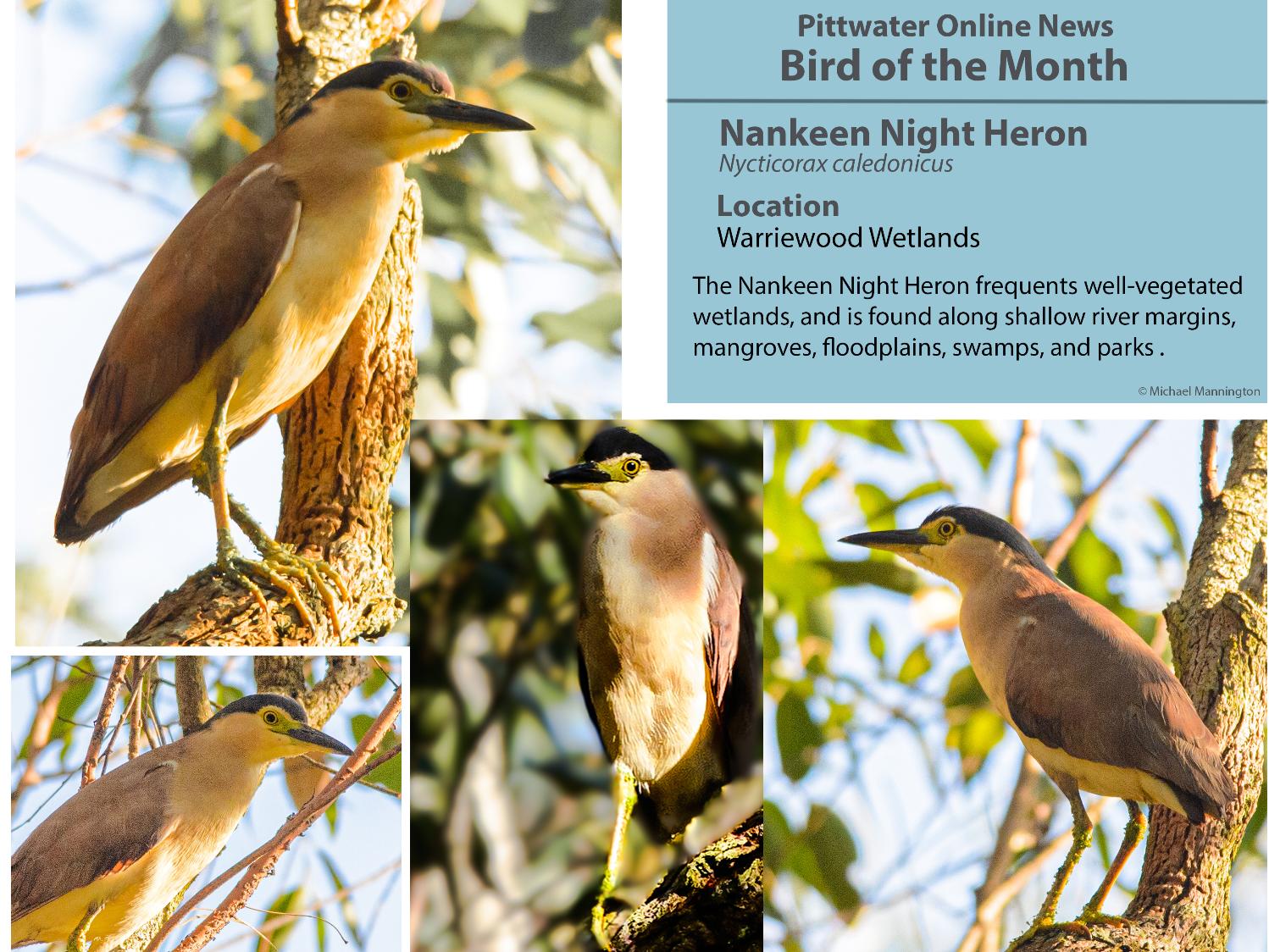
 New Shorebird Identification Booklet
New Shorebird Identification Booklet
The Migratory Shorebird Program has just released the third edition of its hugely popular Shorebird Identification Booklet. The team has thoroughly revised and updated this pocket-sized companion for all shorebird counters and interested birders, with lots of useful information on our most common shorebirds, key identification features, sighting distribution maps and short articles on some of BirdLife’s shorebird activities.
The booklet can be downloaded here in PDF file format: http://www.birdlife.org.au/documents/Shorebird_ID_Booklet_V3.pdf
Paper copies can be ordered as well, see http://www.birdlife.org.au/projects/shorebirds-2020/counter-resources for details.
Download BirdLife Australia's children’s education kit to help them learn more about our wading birdlife
Shorebirds are a group of wading birds that can be found feeding on swamps, tidal mudflats, estuaries, beaches and open country. For many people, shorebirds are just those brown birds feeding a long way out on the mud but they are actually a remarkably diverse collection of birds including stilts, sandpipers, snipe, curlews, godwits, plovers and oystercatchers. Each species is superbly adapted to suit its preferred habitat. The Red-necked Stint is as small as a sparrow, with relatively short legs and bill that it pecks food from the surface of the mud with, whereas the Eastern Curlew is over two feet long with a exceptionally long legs and a massively curved beak that it thrusts deep down into the mud to pull out crabs, worms and other creatures hidden below the surface.
Some shorebirds are fairly drab in plumage, especially when they are visiting Australia in their non-breeding season, but when they migrate to their Arctic nesting grounds, they develop a vibrant flush of bright colours to attract a mate. We have 37 types of shorebirds that annually migrate to Australia on some of the most lengthy and arduous journeys in the animal kingdom, but there are also 18 shorebirds that call Australia home all year round.
What all our shorebirds have in common—be they large or small, seasoned traveller or homebody, brightly coloured or in muted tones—is that each species needs adequate safe areas where they can successfully feed and breed.
The National Shorebird Monitoring Program is managed and supported by BirdLife Australia.
This project is supported by Glenelg Hopkins Catchment Management Authority and Hunter Local Land Services through funding from the Australian Government’s National Landcare Program. Funding from Helen Macpherson Smith Trust and Port Phillip Bay Fund is acknowledged.
The National Shorebird Monitoring Program is made possible with the help of over 1,600 volunteers working in coastal and inland habitats all over Australia.
The National Shorebird Monitoring program (started as the Shorebirds 2020 project initiated to re-invigorate monitoring around Australia) is raising awareness of how incredible shorebirds are, and actively engaging the community to participate in gathering information needed to conserve shorebirds.
In the short term, the destruction of tidal ecosystems will need to be stopped, and our program is designed to strengthen the case for protecting these important habitats.
In the long term, there will be a need to mitigate against the likely effects of climate change on a species that travels across the entire range of latitudes where impacts are likely.
The identification and protection of critical areas for shorebirds will need to continue in order to guard against the potential threats associated with habitats in close proximity to nearly half the human population.
Here in Australia, the place where these birds grow up and spend most of their lives, continued monitoring is necessary to inform the best management practice to maintain shorebird populations.
BirdLife Australia believe that we can help secure a brighter future for these remarkable birds by educating stakeholders, gathering information on how and why shorebird populations are changing, and working to grow the community of people who care about shorebirds.
To find out more visit: http://www.birdlife.org.au/projects/shorebirds-2020/shorebirds-2020-program
Bushcare In Pittwater
Where we work Which day What time
Avalon
Angophora Reserve 3rd Sunday 8:30 - 11:30am
Avalon Dunes 1st Sunday 8:30 - 11:30am
Avalon Golf Course 2nd Wednesday 3 - 5:30pm
Careel Creek 4th Saturday 8:30 - 11:30am
Toongari Reserve 3rd Saturday 9 - 12noon (8 - 11am in summer)
Bangalley Headland 2nd Sunday 9 to 12noon
Bayview
Winnererremy Bay 4th Sunday 9 to 12noon
Bilgola
North Bilgola Beach 3rd Monday 9 - 12noon
Algona Reserve 1st Saturday 9 - 12noon
Plateau Park 1st Friday 8:30 - 11:30am
Church Point
Browns Bay Reserve 1st Tuesday 9 - 12noon
McCarrs Creek Reserve Contact Bushcare Officer To be confirmed
Clareville
Old Wharf Reserve 3rd Saturday 8 - 11am
Elanora
Kundibah Reserve 4th Sunday 8:30 - 11:30am
 Mona Vale
Mona Vale Mona Vale Beach Basin 1st Saturday 8 - 11am
Mona Vale Dunes 2nd Saturday +3rd Thursday 8:30 - 11:30am
Newport
Bungan Beach 4th Sunday 9 - 12noon
Crescent Reserve 3rd Sunday 9 - 12noon
North Newport Beach 4th Saturday 8:30 - 11:30am
Porter Reserve 2nd Saturday 8 - 11am
North Narrabeen
Irrawong Reserve 2nd Saturday 2 - 5pm
Palm Beach
North Palm Beach Dunes 3rd Saturday 9 - 12noon
Scotland Island
Catherine Park 2nd Sunday 10 - 12:30pm
Elizabeth Park 1st Saturday 9 - 12noon
Pathilda Reserve 3rd Saturday 9 - 12noon
Warriewood
Warriewood Wetlands 1st Sunday 8:30 - 11:30am
Whale Beach
Norma Park 1st Friday 9 - 12noon
Western Foreshores
Coopers Point, Elvina Bay 2nd Sunday 10 - 1pm
Rocky Point, Elvina Bay 1st Monday 9 - 12noon
Gardens And Environment Groups And Organisations In Pittwater
Pittwater Reserves
Aussie Bread Tags Collection Points

DIY Ideas A Job For Life: Apprentice Carpenter + Commencement Tool List
Around now some of our school leavers may be considering what options they wish to explore as not everyone wants to go to university. With this in mind we'll alternate DIY Projects in the DIY Idea pages with information on what's out there and what help you can get to set yourself up in a career that interests you. You won't have to get your haircut BUT you will secure a real job in an industry that interests you and on getting your ticket will have autonomy for life - the penultimate definition of 'DIY' really. All you have to do is follow through and complete the study and work entailed.
Worth noting is the NSW Government is investing an additional $285 million over six years to fund the qualification fees for 100,000 new apprentices from July 1st 2018. This saves you from having to pay up to $2,000 for training costs per apprentice. (Please note this is for apprentices only, not trainees) Find out more about Fee Free Apprenticeships at: www.tafensw.edu.au/fee-free-apprenticeships
There is also a range of other help, support and incentives for those who want to do this through a traineeship - for those over 21 - with fee caps there too.
To start off with, one for those who like working with wood.
CERTIFICATE III IN CARPENTRY
National Course Code: CPC30211
Become a highly sought-after carpenter when you undertake the nationally accredited Certificate III in Carpentry. Study as an apprentice or get recognised for your industry experience in this practical, hands-on course. Carpenters and joiners are in high demand in a skills shortage industry.
TAFE NSW code: CPC30211-01V03-20NBC-477 ; Location – Northern Beaches, Main Campus (Apprenticeship) - visit: www.tafensw.edu.au/CPC30211-01V03-20NBC-477/Certificate-III-in-Carpentry
Exploring Your Options: Information Sessions Available In Further Study
LIVESTREAM UNSW Undergraduate Info and Insights Week
23 to 25 June
Designed for Year 11 and 12 students, we'll cover everything from scholarships and admissions to the UNSW student experience through a series of short livestreamed presentations. At the end of each session, you'll have the opportunity to participate in a live Q&A, where you can get all your questions answered.
https://www.events.unsw.edu.au/event/livestream-unsw-undergraduate-info-and-insights-week
Southern Cross Uni - Virtual Gold Coast Careers Festival
To 31 July
Want to discover your career pathway? We can help you explore your options at the virtual Gold Coast Careers Festival.
Engage with our educators, gain advice from qualified professionals, discover insights in engaging webinars, and obtain up to date advice through online live chat.
A world of opportunity awaits you. Whether you have no idea what career you want to pursue or you know exactly what you are aiming for, we can show you how to achieve your dream career.
Register your attendance.
https://www.scu.edu.au/engage/events/virtual-gold-coast-careers-festival.php
ACU Open Days are Moving Online
ACU Open Days give students the opportunity to ask questions about their dream course, the application process, pathway options, entry schemes and more. There will be three 2020 ACU Open Days shared across NSW and ACT on the 29th of August, and the 5th and 12th of September. Students can follow this link below to keep up to date with the 2020 Open Days.
Visit: acu.edu.au/uni-experience
UOW College Australia Now Accepting applications for 2021
UOW College provides pathways to the University of Wollongong. We offer uni preparation courses to support students and progress to university studies. We also provide VET courses for students seeking work-ready qualifications in Nursing or Fitness. These can also be used for a direct pathway to a bachelor level study. Find out more at below.
https://www.uowcollege.edu.au/study/high-school/
ACU - Talk with Exercise Scientists and Physiotherapists
1 July. 6pm
Join us online to hear from ACU alumni about their experiences working as exercise scientists, clinical exercise physiologists, sports scientists and physiotherapists. Take part in a Q&A session with our graduates to learn what a career in exercise science and physiotherapy is like.
CSESoc CompClub
CompClub is an organisation under UNSW CSESoc that promotes computing to high school students through free workshops.
2020 Virtual Winter Workshops
This year we will be providing 3 free workshops in an online format instead of in person! We will have a series of videos covering three workshops:
- Game Development (HTML/CSS)
- Cyber Security
- Web Development (Javascript)
There will also be a livestream covering an introduction to Python during the holidays (date TBD), where students can take part and ask questions in real time! We will be releasing the workshop videos on a schedule, starting on Monday 6th July.
There is no cost or registration needed and is open to all high school students of any ability. We will be releasing the virtual workshop site closer to the Winter School Holidays, and will update the link here once it is ready!
Visit: https://2020.compclub.com.au/

But Wait - There's More! Everything From Trains To Tractors Is Knocking On Your Door
Top Gun Apprenticeship Program
Applications now open for 2021 Apprenticeships with Land HQ top Gun program.
Whether you’re a school leaver or someone looking for a change in career path, our TOPGUN apprenticeship program could give you the start you’re looking for with LandHQ. We have apprenticeship opportunities available in Nowra, Penrith and Bowral. Go to the site below or to find out more contact Matt on 0428 613 284 or email hr@landhq.com.au:
Visit: http://landhq.com.au/careers
Sydney Trains Apprenticeships - Join the team that keeps Sydney moving!
We advertise apprenticeship positions in July on: https://iworkfor.nsw.gov.au and our apprentices commence in January of the following year.
If you’re looking for a rewarding career in a boom industry, there’s never been a better time to join the rail industry. Sydney Trains is the biggest passenger rail operator and maintainer in Australia and is the training ground for the NSW rail industry.
Sydney Trains offers a range of apprenticeships (PDF, 1.05 MB) in the electrical, telecommunications and mechanical engineering trades.
As a Sydney Trains apprentice, you’ll have access to a wealth of experience, a workforce that takes pride in its work, and a culture of collaboration and innovation. You’ll gain nationally recognised trade qualifications with opportunities to further develop your career post trade. Visit: https://www.transport.nsw.gov.au/sydneytrains/careers/sydney-trains-apprentices
For further information please contact Rhonda Moore on 0428 166 359 or email sydneytrainsapprenticeships@transport.nsw.gov.au
Electrical Pre-apprenticeship Program for Women
Sydney Trains has a genuine commitment to workforce diversity and has introduced some targeted recruitment programs to attract more women to apply for its apprenticeships.
The Electrical Pre-apprenticeship Program for Women (PDF, 1.2 MB) is a 3-week program in collaboration with an external training organisation that offers participants three national units of competency from the Certificate II in Electrotechnology. This program has proven to be very effective in assisting women interested in gaining an electrical apprenticeship.
The 2020 Program is on hold at present, but we are accepting expressions of interest and applicants will be contacted when confirmation is available - sydneytrainsapprenticeships@transport.nsw.gov.au.
Work Experience Program
Our Work Experience Program (PDF, 41.71 KB) offers opportunities for students to experience the world of work at Sydney Trains and gain a better understanding of the career options available in the rail industry.
You can spend a week with us and learn about:
- Diesel/Plant mechanics with our Heavy Plant team, which repairs and maintains a large fleet of track maintenance machines
- Our Business Studies program which will provide opportunities to gain experience at our training facility at Petersham in a range of office procedures and tasks
- Electro-technology apprenticeship options across our rail network including theory and practical training on rail signalling, rail substations, rail traction and everything you ever wanted to know about trains at one of our fleet maintenance depots.
Contact us
For further information please email us at: sydneytrainsapprenticeships@transport.nsw.gov.au.
Apprenticeships R Us – Keep an eye on the Apprenticeship Job Vacancies with Cars
The positions indicated below are our current vacancies that we are recruiting for right NOW. If you are a job seeker looking for an immediate start to your automotive apprenticeship and you see an apprenticeship that is right for you then don't delay and start an apprenticeship with us.
Visit: https://www.apprus.com.au/career-vacancies
Get a Dynamic Career with the TAFE NSW Bachelor of Early Childhood Education and Care (Birth-5)
Have you shown a keen interest in working with children? You may have a genuine desire to help our next generation grow and develop. A TAFE NSW degree in this career area is designed to develop early childhood teachers who can integrate theoretical knowledge into practical education and care skills. More info here: https://www.tafensw.edu.au/degrees/bachelor-of-early-childhood-education-and-care-birth-5
TAFE Bachelor of Applied Commerce
Designed in consultation with industry, the Bachelor of Applied Commerce provides you with the skills and knowledge you need to be a successful financial professional. Complete your major in either accounting or financial planning, or do a double major. As well as developing knowledge and skills in accounting and financial planning, you will study management, marketing, law, economics and business statistics, as well as doing an industry placement.
Alternatively, you can complete a Diploma of Applied Commerce by completing all first year subjects in the degree. Visit: https://www.tafensw.edu.au/degrees/bachelor-of-applied-commerce
Australian Patisserie Academy
250 Blaxland Road Ryde
Established in 2014, the TAFE NSW Australian Patisserie Academy was designed to give food enthusiasts, culinary professionals, businesses and individuals the opportunity to immerse themselves in the world of patisserie. Utilising the professional kitchens of TAFE NSW, the Academy team alongside international guest chefs, ensure you emerge with a dream patisserie skill set. From perfecting the art of cake decorating to baking the perfect sourdough, pulling exquisite sugar ribbons to creating one-of-a-kind chocolate show pieces, the Academy is dedicated to preserving the art of patisserie.
Classes are short, flexible and constantly changing to reflect industry trends. So whether you’re a passionate weekend baker or master chocolatier, there’s a course that’s your perfect mix.
Phone: 02 9448 6222 or Visit: https://www.tafensw.edu.au/australian-patisserie-academy?
Health and Fitness Careers - TAFE Career Snapshot
Which occupations in this industry are likely to have the largest employment growth over the next three years?
Visit: https://www.tafensw.edu.au/documents/60140/219174/Careers-Snapshot_Health_and_Fitness.pdf
Tourism Hospitality and Events - TAFE Career Snapshot
Which occupations in this industry are likely to have the largest employment growth over the next three years?
Automotive Trades and Services TAFE Career Snapshot
Which occupations in this industry are likely to have the largest employment growth over the next three years?
Where Can Students Find Out More About Tocal College
Take a tour on any area that takes your interest. Dairy, beef, sheep, horses, eggs, property, natural resources, bees. Other sources include our Website, Facebook, Careers Markets, 2019 AgVision or school tours. 02 4939 8888 or 1800 025 520. Visit: https://www.tocal.nsw.edu.au/farm-and-facilities/tocal-farms/tocal-virtual-farm-navigation
The Tocal Beekeepers Field Day
Saturday 10th October from 9am
Without bees we have no agriculture. Get along to this great event. There will be a full program of informative presentations, a large trade show to buy beekeeping supplies and more, live demonstrations, honey tasting and sales, and food and coffee available all day. Entry is free!
The Tocal Beekeepers Field Day has been running for 40 years, and is run by the Amateur Beekeepers Association, NSW Apiarists Association, NSW Department of Primary Industry and Tocal College.
Visit: https://www.tocal.nsw.edu.au/news-and-media/events/2020-tocal-beekeepers-field-day
Reminder - Tocal Farming and Agriculture Open Days
Friday 10 & 17 July
Friday 2 & 9 October
Our College Open Days are a wonderful opportunity to visit Tocal and experience first hand all that it can offer students who are eager for a rewarding career in agriculture, agribusiness or horse breeding and training.
The Open Days are held on the Fridays of the winter and spring school holidays and provide prospective students, their families and carers an ideal forum to visit the College and get a feel for what life as a student is really like. Should you require accommodation while attending the Open Days, Tocal College has a range of excellent and affordable accommodation options. These include motel rooms, flats and cottages. Please contact our accommodation booking team for further information at tocal.bookings@dpi.nsw.gov.au
Visit: https://www.tocal.nsw.edu.au/students/future-students/open-days
Minister For Education Dan Tehan National Press Club Address
June 19, 2020
I would like to begin by acknowledging the traditional custodians of the land on which we meet today, the Ngunnawal people, and pay my respects to their elders past, present, and emerging.
Almost a year ago, I stood here at the Press Club and outlined our Government’s vision for higher education.
To achieve it, I said, would require a resetting of the relationship with the higher education sector, reshaping its architecture and renewing our commitment to work together.
At that time, I made the observation that “a job is more than a vehicle to earn money. It provides a sense of self and a means to contribute to your family, your community and the nation.”
That has not changed. If anything, the economic and social disruption caused by COVID-19 has brought home the truth of that statement.
COVID-19 means we must double down on our core mission of educating Australians for the jobs that will be in demand in the future.
Our Government wants to keep Australians in jobs, and to educate the next generation of Australians to get a job.
Our nation has faced adversity before and we have risen to the challenge – we have done so by looking after each other and backing ourselves.
Australian hard work and Australian innovation will drive our recovery from COVID-19.
As the Prime Minister said in his recent Press Club address, to secure Australia’s future we must leverage and build on our strengths, including an educated and highly-skilled workforce.
We want our students to receive an education that sets them up for future success –because if graduates succeed, they will power an economic recovery that benefits all Australians.
And, when the economy is facing its greatest economic shock since the Great Depression, success looks like a job.
Projections prepared before the COVID-19 pandemic showed that over the five years to 2024 it is expected that the overwhelming majority of new jobs will require tertiary qualifications – and almost half of all new jobs will go to someone with a bachelor or higher qualification.
Health care is projected to make the largest contribution to employment growth, followed by:
- Science and Technology,
- Education, and
- Construction.
These four industries are projected to provide 62 per cent of total employment growth over the next five years. This is part of a long-term structural shift.
Universities must teach Australians the skills needed to succeed in the jobs of the future.
We know that people turn to education during economic downturns and we also know the Costello Baby Boom generation will begin to finish school from 2023.
So we must address the increased demand for a qualification with a renewed focus on our students.
Today, I announce our plan for more job-ready graduates.
It will only be achieved if the Government and the higher education sector work together.
Our package offers universities a strong partnership with government and business to ensure they play a key role in Australia’s recovery from COVID-19.
Crucially, it was designed in consultation with key leaders from the sector and industry.
A year ago I promised this would be a feature of my approach to reform, and today I reinforce that this will continue to be the case.
Our package provides opportunities across three objectives:
One: Increase the number of graduates in areas of expected employment growth and demand, such as teaching, nursing, agriculture, STEM and IT.
Two: Lift the education attainment for students in regional Australia.
Three: Strengthen relationships with business to drive workforce participation and productivity.
To achieve objective one we need more tertiary places for Australian students.
We also need more nurses, scientists and psychologists.
Today I announce that we will provide an additional 39,000 university places by 2023 and 100,000 places by 2030.
To do this, we will address the misalignment between the cost of teaching a degree and the revenue that a university receives to teach it.
We will reform the system so that the student contribution and the Commonwealth contribution actually equals the cost of teaching that degree.
This is consistent with the reforms we are undertaking in vocational education and training.
We will also incentivise students to make more job-relevant choices, that lead to more job-ready graduates, by reducing the student contribution in areas of expected employment growth and demand.
It’s a similar model to the one we used rolling out our microcredential initiative that offers short, online courses in areas of expected job demand.
With our reforms:
- Students who study teaching, nursing, clinical psychology, English and languages will pay 46 per cent less for their degree.
- Students who study agriculture and maths will pay 62 per cent less for their degree.
- Students who study science, health, architecture, environmental science, IT, and engineering will pay 20 per cent less for their degree.
Medicine, dental, and veterinary science students will see no change to the cost of their degree.
In total, we expect that 60 per cent of students will see a reduction or no change in their student contribution.
To deliver cheaper degrees in areas of expected employment growth, students who choose to study more popular degrees will make a higher contribution.
The student contribution for Law and Commerce will increase by 28 per cent, for the Humanities it will be 113 per cent.
Students will still pay less for those degrees in Australia than they would for a similar degree in similar countries, like the USA and the UK.
Importantly, the changes are based at a unit level not a degree level. This means that students studying Arts can still reduce their total student contribution by choosing electives in subjects like mathematics, English, science and IT within their degree.
We are encouraging students to embrace diversity and not think about their education as a siloed degree.
So if you want to study history, also think about studying teaching.
If you want to study philosophy, also think about studying a language.
If you want to study law, also think about studying IT.
Importantly, no current student will be worse off. No current student will pay an increased student contribution. Their fee contributions will be grand-fathered.
Existing students set to gain from this policy will be able to do so from next year.
From next year, students will have a choice. Their degree will be cheaper if they choose to study in areas where there is expected growth in job opportunities.
Let me be clear.
This does not mean fee deregulation.
This does not mean one hundred thousand dollar degrees.
And our Government will continue to provide record funding for higher education, including through the HELP scheme, and that funding will increase over time.
We are putting more funding into the system in a way that encourages people to study in areas of expected employment growth.
We are facing the biggest employment challenge since the Great Depression. And the biggest impact will be felt by young Australians. They are relying on us to give them the opportunity to succeed in the jobs of the future.
A cheaper degree in an area where there’s a job is a win-win for students. And as I said earlier, when graduates succeed our country succeeds.
It’s common sense. If Australia needs more educators, more health professionals and more engineers, then we should incentivise students to pursue those careers.
Students will always have the freedom to choose what they want to study – and because the Government continues to offer one of the world’s best student loan schemes, no student will be denied a place because they do not have the capacity to pay.
For the sector, this means a return to indexing of all Commonwealth Grant Scheme funding by CPI, maintaining the real value of funding for domestic students.
For the taxpayer, it means we can fund additional places that can be distributed to areas of workforce need or areas of low attainment and high population growth.
To achieve objective two, we must address the discrepancy where young Australians in regional areas are half as likely to obtain a university qualification as Australians who live in the city.
These reforms will also allow us to support more regional, rural and Indigenous students to access higher education, because our Government believes that every Australian should have access to a world-class education.
This is vital for our cohesion as a nation going forward.
Halving the gap in attainment and participation rates in regional and remote areas by 2030 will increase GDP by 0.6 per cent by 2050, or around $25 billion a year.
We will support regional, remote and Indigenous students to undertake high-level tertiary studies.
We will grow university places in regional Australia by 3.5 per cent a year.
And we will also support regional universities to better serve their local communities.
We will introduce a new Tertiary Access Payment of $5,000 to support students from outer regional, remote and very remote areas who relocate to study a Certificate IV or higher, for at least one year.
This was a key recommendation made by Dr Denis Napthine in the National Regional, Rural and Remote Education Strategy, which our Government made an election commitment to implement.
In addition to this new payment, we are making improvements to Fares Allowance, to make it easier for relocated students to travel home during their first year of study.
Our Government will also establish a new fund to provide $500 million a year to universities for programs that support Indigenous, regional and low SES students to get into university and to graduate.
Universities can access funding to design and run their own programs suitable to their local conditions.
Indigenous Australians from regional and remote areas have the lowest rates of higher education participation and attainment.
We will support more Indigenous students from regional and remote areas to go to university by providing a guaranteed bachelor-level Commonwealth supported place at any public university.
Regional universities train the next generation of professionals who work in regional Australia, including in health care, teaching and agriculture.
The Government will establish a $48.8 million research grants program to fund regional universities to partner with industry and other universities to boost their research capacity.
The Coalition will provide an additional $21 million to establish more Regional University Centres so people can get a tertiary education while living and working in regional Australia.
We have already committed more than $53 million to establish 25 Regional University Centres across regional Australia, from the west coast of Tasmania, to Kadina in South Australia and Balonne in south west Queensland.
We will continue to provide leadership when it comes to regional education.
Today, I can announce the Government will establish the role of Regional Education Commissioner.
The Commissioner will oversee the implementation and monitoring of the Government’s Regional Education Strategy.
In summary, we will be providing an additional $400 million over four years for regional students, universities and communities to lift higher education attainment.
To achieve objective three we will strengthen the relationship between all universities and business.
We are encouraging universities and industry to work together. Doing so will make our graduates even more job-ready, and drive productivity improvements, innovation and discovery.
Our Government has funded four projects that bring together universities and business on research innovation and workforce preparation.
For example, the Government is funding a pilot program in Adelaide where 50 ASC Shipbuilding employees are learning new digital skills and defence contract requirements to better prepare them to work on Australia’s continuous naval shipbuilding project.
The pilot is focusing on work-integrated learning to upskill employees in engineering tools and systems relevant to the new ‘digital shipyard’.
Today, I can announce the Coalition Government will provide a further $900 million to establish the National Priorities and Industry Linkage Fund — with a strong focus on investment in STEM industries — to support universities to produce job-ready graduates for their local industries and communities.
Similar to the co-creation of the performance-based funding model, we will work with representatives from the sector to develop performance metrics, such as:
- Increasing the number of internships and practicums;
- Increasing the number of STEM graduates and improving their employment outcomes; and
- Rewarding formal research partnerships with industries and advanced apprenticeships.
We will also address the current disincentive where less funding is provided for units that involve students undertaking certain types of work experience.
Improving how we connect graduates to employers, as well as tailoring education and training to ensure young peoples’ skills meet industry demand, is critical to the recovery of the youth labour market.
Getting on-the-job training as part of your degree is invaluable and leads to better job outcomes when you leave university.
The Prime Minister has challenged the vocational education and training sector to strengthen its focus on industry needs, and our universities must do likewise.
The package announced today sets students and our universities on a clear course for success.
We are providing more university places for domestic students in areas of expected employment growth.
We are forging a stronger relationship between universities and industry to drive innovation, productivity gains and produce highly-skilled graduates.
We are providing more support for students outside the capital cities because every Australian should have access to a world-class education.
The reforms announced today will interact with the other reforms our Government is delivering as it reshapes the architecture of higher education.
This reshaping is taking place through the implementation of a series of thoughtful and methodical reviews led by eminent Australians, and produced in close consultation with the sector.
In just two months we have opened the door to the recognition of microcredentials and other short courses through the Australian Qualifications Framework.
We are encouraging greater provider diversity by creating ‘university colleges’ that could lead to the establishment of teaching only institutions.
We are providing more money through increased places where universities are producing job-ready graduates, through the performance-based funding model.
We have a model code to ensure free speech and academic freedom as well as a framework for universities to address foreign interference.
And, last week, the Review of Senior Secondary Pathways by Peter Shergold was presented to Education Council. The review sets out ways to help young people and potential students make better informed decisions about whether to choose higher education, vocational education, employment or a mixture of the three.
Our reforms are being implemented to support universities to strengthen their focus on domestic students, and strengthen the mutually beneficial relationship with business and government.
We are introducing flexibility and we are rewarding success.
Universities have demonstrated that they can be innovative and flexible.
We saw that in their response to our Government’s microcredential initiative, where higher education providers were incentivised to create short, online courses in areas of skills shortage.
These microcredentials were introduced to give Australians the opportunity to learn new skills quickly that, in turn, would make them more employable in areas of national demand.
The courses are significantly discounted for students, with up to 74 per cent of the total course fee paid by our Government.
A key feature of this initiative has given universities the flexibility to adjust the number of bachelor, sub bachelor and postgraduate places within their funding allocation.
The response from universities has been overwhelming and demonstrates their capacity for innovation.
Right now, there are 54 providers offering 344 short courses.
Our Government has supported this further by adding ‘Undergraduate Certificate’ as a recognised qualification.
We want short courses to be a permanent fixture of the Australian higher education system, and lock in the flexibility for providers.
To encourage more flexibility and diversity, we opened our microcredential initiative to non-university higher education providers, and our Government provided $7 million to subsidise 1,015 places.
To further support private providers, we will lower the FEE-HELP loan fee for students studying at private providers to align with the charge for VET providers.
The development of microcredentials will drive innovation within higher education, making providers more efficient, relevant to industry and responsive to the requirements of domestic students.
Microcredentials also present an opportunity for universities to become global leaders in an emerging form of education, opening new markets and potential revenue streams.
Universities will need to call on that innovation again, in our response to COVID-19.
When it comes to international students, there are reasons to be positive.
Analysis by consultants EY cites industry observers and participants in major source countries who expect demand for international education will remain strong post COVID-19, if borders start to open by 2021.
And Australia is in a strong position because of the success of our response to the coronavirus.
On top of the myriad of reasons why international students choose to study in Australia, we can add three more:
One: A country that is successfully suppressing COVID-19
Two: Access to a world-leading health system, and
Three: Political and social stability.
EY’s high-level analysis predicts Australia could potentially gain a two per cent share of new international enrolments as students shift their study preference to countries that have successfully managed COVID-19.
And we are taking our first cautious steps towards international students returning much earlier than anyone would have predicted a few months ago, with National Cabinet last week agreeing to work closely and carefully on the return of international students through small, controlled pilot programs, provided internal borders are open and students are back on-campus.
This is important because international education builds our connections to the rest of the world, supports 250,000 Australian jobs and contributed $40 billion to our economy last year.
But even as we safely re-open to international students, the fallout from the COVID-19 pandemic shows us that the sector must adapt.
I want to work with the sector to develop a strategy to mitigate against future disruptions, for example, by putting in place improved prudential requirements.
We have seen how revenue from international students helps fund research in this country.
One of the key challenges in a post-COVID economy will be to provide a sustainable pipeline of funding for research. I want to work with the sector to achieve this.
Our Government wants universities to be even more entrepreneurial and engaged with industry.
In the post-COVID world, universities need to re-focus on domestic students and offer greater alignment with industry needs.
They will be required to retrain or re-skill current workers through new and targeted programs that help them get back to work.
Our educated and highly-skilled workers will need a mixture of certified skills, university degrees, graduate qualifications, apprenticeships and advanced diplomas.
This means, once and for all, resetting the relationship between the two streams of education: higher education and vocational education and training.
We must enhance and improve how the two systems interact so students can move more seamlessly from one to the other over the course of their education.
National Cabinet will play a central role in delivering this key reform.
The package announced today continues our Government’s consistent approach to reform in higher education as a reshaping of the architecture.
If we give universities the right tools now, they will educate the next generation of job-ready graduates to help power our economic recovery.
As I said at the start of this speech, our nation has faced adversity before and we have risen to the challenge.
When Australia was rebuilding after World War II, then Prime Minister, Sir Robert Menzies, recognised the important role of universities in educating Australians to power our economic recovery.
Funding and enrolment growth for universities increased sustainably under Menzies, and more Australians were given the opportunity to obtain a degree.
Australia harnessed its higher education system to drive its recovery from World War II and make our nation stronger than before the war started.
By harnessing our higher education system once again we can drive our recovery from COVID-19.
Uni Reform Package Boosts Participation But Further Study Of Detail Needed
June 19, 2020: Universities Australia statement
Australia’s universities have welcomed plans to increase domestic student participation in higher education and the commitment to indexation of Government funding, as announced by Education Minister Dan Tehan.
Universities Australia Chair Professor Deborah Terry supported the ambition to fund an extra 39,000 university places by 2023.
“Minister Tehan has clearly heard universities’ concerns about our ability to meet an increase in demand for student places in the coming years. We know that during a recession, demand for a university education goes up.”
“As a nation, we will need a skilled, educated workforce to help drive Australia’s post-pandemic economic recovery.”
“University provides an excellent path to a good job. A university qualification is one of the best investments you can make. Younger women with a university degree still earn almost $14,000 a year more on average, and younger men $12,000 more than school leavers.”
“We also welcome the focus on improving participation and attainment by Indigenous, regional and remote students. Redressing disadvantage is a core aim of all of our universities and we support the new measures to assist with the goal.”
“It is also good to see the regional-industry research collaboration fund.”
“We are also pleased to see that universities and students will have a buffer, with grandfathering for current students, and a transition fund for universities.”
Professor Terry said universities would take time to properly assess the detail of the changes.
“Today’s announcement is wide ranging and contains considerable complexity. We will need to examine it closely in coming days in order to understand the impact on our students including those in the humanities.”
“We are also keen to understand the National Priorities and Industry Linkage Fund, particularly as it relates to our deep commitment to ensure that we can continue to deliver work-ready and skilled graduates in science and engineering.”
____________________________________________________________________________________________________________________________________________________
About Universities Australia
Universities Australia is the voice of Australia’s universities.
As the peak body for the sector, we advocate for the vast social, economic and cultural value of higher education and research to Australia and the world.
On behalf of our 39 member universities, we provide expert policy advice, analysis and statistical evidence, and media commentary on higher education.
We make submissions, develop policy across the sector, represent Australia’s universities on government and industry-appointed bodies and partner with university sectors in other countries to enable bilateral and global collaborations.
We build capacity across the Australian university sector through our flagship annual conferences and high-level policy workshops throughout the year.
And we lift the profile of the extraordinary contributions made by university graduates and research to our society and economy, including through our award-winning public awareness campaign Keep It Clever.
Through Universities Australia and our subsidiary Higher Ed Services, member universities also have access to collective procurement and licensing agreements.
Universities Australia is funded by annual contributions from member universities.
Fee cuts for nursing and teaching but big hikes for law and humanities in package expanding university places
Michelle Grattan, University of CanberraThe federal government will fund an extra 39,000 university places by 2023 in a package that will restructure the amounts students have to pay for courses to encourage them to “make more job-relevant choices”.
Under the plan to produce “job-ready graduates”, to be outlined on Friday by Education Minister Dan Tehan, those opting for teaching, nursing, clinical psychology, English and languages would pay 46% less for their degree.
But the student contribution for the humanities would soar by 113%, and the costs for law and commerce would jump by 28%. These are the “more popular” courses, Tehan says in his speech, released in part ahead of delivery.
Students in agriculture and maths would pay 62% less, while those studying science, health, architecture, environmental science, IT, and engineering would be 20% better off.
There would be no change for medicine, dental, and veterinary science students.
“In total, we expect that 60% of students will see a reduction or no change in their student contribution,” Tehan says.
The universities package, which will require legislation, strongly reflects Scott Morrison’s jobs-oriented approach to all main policy areas in the wake of COVID.
Graduates from more vocationally-oriented degrees have higher employment rates. For example those from engineering, education, health, management and commerce and information technology have rates above 75%.
Under the plan, no current student would pay an increased contribution.
Tehan stresses the reform is not deregulating fees.
The government plan provides for an additional 100,000 places by 2030.
Tehan says projections prepared before COVID indicated over the five years to 2024 the overwhelming majority of new jobs were expected to require tertiary qualifications, with almost half of all new jobs going to someone with a bachelor or higher qualification.
The projections have health care making the largest contributions to employment growth, followed by science and technology, education, and construction. As part of a long-term structural shift, these four industries are projected to provide 62% of total employment growth over the next five years, Tehan says.
“Universities must teach Australians the skills needed to succeed in the jobs of the future,” he says.
The government’s measures aim to
boost numbers of graduates in areas of expected employment growth, including teaching, nursing, agriculture, STEM and IT
lift the education attainment for students in regional areas
strengthen relationships with business to drive workforce participation and productivity.
The plan would rectify the “misalignment between the cost of teaching a degree and the revenue that universities receive to teach,” Tehan says. Under the changes the student and Commonwealth contribution would equal the cost of teaching the degree.
It would provide an incentive for students “to make more job-relevant choices, that lead to more job-ready graduates, by reducing the student contribution in areas of expected employment growth and demand.”
Proposed New Clusters And Bands Design
Tehan says the changes are based at a unit level not a degree level, so an arts student could reduce their total cost by including electives in subjects like mathematics, English, science and IT.
“We are encouraging students to embrace diversity and not think about their education as a siloed degree.
"So if you want to study history, also think about studying English.
"If you want to study philosophy, also think about studying a language.
"If you want to study law, also think about studying IT,” Tehan says.
“Existing students set to gain from this policy will be able to do so from next year.
"Students will have a choice. Their degree will be cheaper if they choose to study in areas where there is expected growth in job opportunities,” Tehan says. “A cheaper degree in an area where there’s a job is a win-win for students.”![]()
Michelle Grattan, Professorial Fellow, University of Canberra
This article is republished from The Conversation under a Creative Commons license. Read the original article.
Humanities graduates earn more than those who study science and maths

Education minister Dan Tehan has announced changes to funding rates for university courses as part of a plan to create “job ready graduates”.
He said:
Projections prepared before the COVID-19 pandemic showed that over the five years to 2024 it is expected that the overwhelming majority of new jobs will require tertiary qualifications – and almost half of all new jobs will go to someone with a bachelor or higher qualification.
Under the new plan, students doing teaching, nursing, clinical psychology, English and languages will pay 46% less for their degree from next year.
Students in agriculture and maths will pay 62% less, while those studying science, health, architecture, environmental science, IT, and engineering will be 20% better off.
But the student contribution for the humanities will go up by 113%, and the costs for law and commerce will jump by 28%.
The rationale is to encourage students to select courses with the best employment outcomes.
Tehan said health care is projected to make the largest contributions to employment growth, followed by science and technology, education and construction.
He said these industries are projected to provide 62% of total employment growth over the next five years.
Although there will be no change in course fees for medicine, dental, and veterinary science students.
With a forecasted rise in unemployment due to the COVID-19 pandemic, Tehan is expecting more young people to go to university, and others to return to re-skill.
National figures show about 93% of graduates who are available for work are employed three years after completing their bachelor degree.
While science, technology, engineering and maths (STEM) graduates are a focus of Tehan’s reforms, not all STEM graduates have above-average employment outcomes. After three years, the overall employment rate of engineering graduates is 95%, while science and maths graduates have a 90.1% rate of overall employment.
And science and maths graduates actually earn less than those with a degree in the humanities.
Which University Students Get Jobs?
Undergraduates who study physiotherapy and occupational therapy have the highest level of employment (98.8%) three years after finishing their bachelor degree, while creative arts graduates the lowest (89.3%).
Of the study areas where the government is proposing students contribute more, law graduates (95.8%) and business graduates (95.5%) are employed at rates above the average. Humanities graduates are employed at a rate of 91.1% (above science and maths).
The median salary for university graduates differs as well. After three years, medicine graduates earn the most (A$100,000) along with dentistry graduates (A$97,400).
As the graph above shows, humanities and social science graduates (A$70,300) earn more than maths and science graduates (A$68,900).
Will Reforms Help The Coronavirus Class Of 2020?
It is unclear whether these reforms will help school leavers facing an uncertain future.
During a recession many people look to study while the employment market remains weak. In his speech, Tehan said:
We know that people turn to education during economic downturns and we also know the Costello Baby Boom generation will begin to finish school from 2023.
In 2017 the Australian government effectively put a cap on university places, after five years of “demand driven” funding (where government essentially funded the amount of places students were enrolled in).
In practice, this means there are now limits on the number of government subsidised places at universities.
Because of demographics and previous growth in enrolments, the cap was not expected to restrict the number of people going to university until 2023.
But the COVID-19 pandemic means these assumptions may no longer apply.
Normally school leavers follow a number of pathways into the workforce (including going straight to work, or studying a university of vocational education and training course first). Most young people take the university pathway.
However, these school leavers don’t start their courses at the same time.
Read more: Most young people who do VET after school are in full-time work by the age of 25
Around 20-25% of school leavers who go to university before working take a gap year. Travel restrictions and a weaker employment market may mean this year’s school leavers will bring forward their study plans.
There may also be more school leavers who choose to study at university instead of entering the workforce directly after school. For instance, 44% of 18 and 19 year olds who are not studying work in retail, accommodation and food services, and trade.
These industries have suffered large job losses because of the coronavirus pandemic.
A reduction in new apprenticeships and traineeships, fewer jobs and higher youth unemployment mean school leavers may look to enrol in education and training.
Before COVID-19 hit, the number of year 12 students was only projected to go up by around 1-2% in the next few years – meaning minimal demand for extra university places. However, due to COVID-19, there already has been a reported doubling of year 12 students in NSW applying for a university course compared to the same time last year.
The government believes 39,000 extra university places will be created by 2023 because of these changes. But this number is not specifically designed to meet a projected increase in demand because of the coronavirus. Therefore, it is unclear (without the government lifting the cap) whether there will be enough funded university places for school leavers whose plans have been displaced by the pandemic.![]()
Peter Hurley, Policy Fellow, Mitchell Institute, Victoria University
This article is republished from The Conversation under a Creative Commons license. Read the original article.
'The time has come to say something of the forgotten class': how Menzies transformed Australian political debate
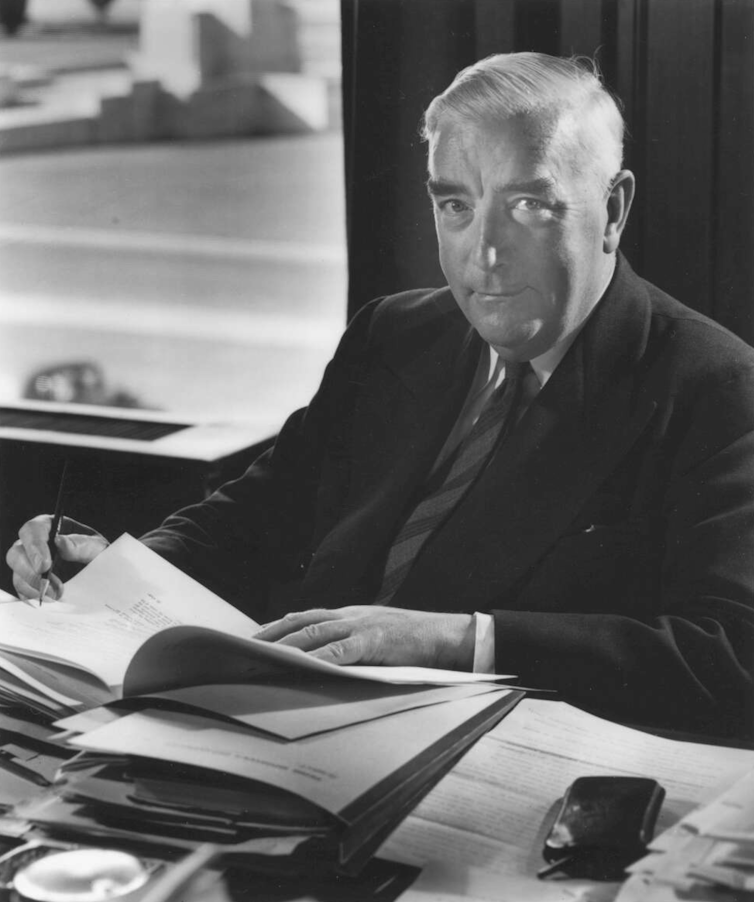
The Conversation is running a series of explainers on key figures in Australian political history, examining how they changed the country and political debate. You can read the rest of the series here.
As Australia’s longest serving prime minister, the career of Robert Menzies remains a model of political success in this country.
Despite this, much of Menzies’s legacy has failed to live long past his time in office, let alone into the 21st century. He was, for instance, firmly in favour of White Australia, obsessed with Australia’s British roots and idolised the monarchy. He also believed the Communist Party ought to be outlawed, and oversaw a highly protected, regulated economy. In many ways, Menzies was the last bastion of an old Australia we would hardly recognise today.
However, there are two notable exceptions – ways in which Menzies did manage to transform Australian political debate in a lasting way: firstly, through his construction of a middle-class political constituency he called “the forgotten people”; secondly, as the founder of the Liberal Party and Coalition.

Rising Through The Ranks
Born in Jeparit, Victoria, in 1894, Menzies rapidly made his way into the elite of Melbourne society. After working as a barrister and later a youthful minister in two Victorian state governments, he was elected to the federal parliament with the United Australia Party in 1934.
Attorney-General Menzies then became prime minister after Joseph Lyons died in office in 1939, just as the second world war broke out.
His factional enemies in the UAP were not impressed by his wartime leadership and, after his closest allies were killed in a plane crash, Menzies was forced out of the leadership in 1941.
Within a year, Labor was in government, and the UAP was collapsing.
This was not the end of Menzies, though. In 1944, he led efforts to reunite various right-of-centre groups to form a new anti-Labor party — the Liberal Party of Australia. He then headed the party’s campaigns against the Labor government’s alleged “socialist” excesses, such as bank nationalisation and petrol rationing.
In 1949, he led the Liberals to a sweeping election victory. Though he had some electoral near misses, and part of his longevity was owed to a fortuitous split in the Labor party, Menzies remained Liberal leader and prime minister until his retirement in 1966.
‘The Forgotten People’
In 1942, as he sought to resurrect his political career, Menzies gave one of Australia’s most famous political speeches, which envisaged a constituency he called “the forgotten people”:
But if we are to talk of classes, then the time has come to say something of the forgotten class - the middle class - those people who are constantly in danger of being ground between the upper and the nether millstones of the false class war; the middle class who, properly regarded, represent the backbone of this country.
These were middle-class, god-fearing citizens, neither rich enough to fend for themselves, nor poor enough to seek trade union representation, and thus lacking power. They would become Menzies’ core constituency, with the party tailoring its policies to helping them meet their modest aspirations for themselves and their families.
Where the UAP had been seen as tied to the upper class and big business, Menzies would seek to attach his party to this ignored middle class, a group more Australians could imagine themselves to be part of, even if they had never thought of themselves in those terms before.
This construct has remained at the centre of Liberal Party rhetoric, reincarnated as John Howard’s “battlers” and Scott Morrison’s “quiet Australians”.
Even Labor has, at times, sought to defer to this supposed “backbone of the nation”. In his first speech to the Press Club as Labor Leader, Anthony Albanese suggested the ALP had lost the 2019 federal election because, to many voters, it failed to be the party of aspiration; essentially, that they neglected Menzies’s forgotten people.
Of course, this is not to say there really is a quiet, unassuming, aspirational majority lurking out in the suburbs. Rather, Menzies’s forgotten people are a rhetorical construct that has grown a life of its own. Politicians believe in this constituency and defer to it, even if it is not, actually, a meaningful voting bloc.
A Liberal-National Coalition
Menzies was also the driving force in creating and holding together the Liberal Party — and indeed the long-term Liberal-National Coalition, an alliance that has historically shifted the focus of political debate.
Read more: Australian politics explainer: Robert Menzies and the birth of the Liberal-National coalition
Keeping liberals, conservatives and rural interests in one bloc has meant the battle for leadership in Australia became a contest between the Coalition and Labor. This was no easy feat. Indeed, until 1944, there had been numerous minor parties campaigning on the right of the political spectrum. Some were reluctant to join Menzies’s new party, given that it would be a “liberal”, rather than “conservative” party.
Free-traders and economic moderates frequently fell out over welfare and tarrifs; hard-line conservatives and social liberals had serious disagreements over censorship, multiculturalism and other social issues. However, Menzies managed to unite them under what Howard would later call the Liberal Party’s “broad church” by focusing on Labor’s “socialism” and the international threat of communism. This appeal similarly kept the Nationals as Coalition partners. Menzies said:
In 1949 we were swept into power at what was then an almost record level of majority. Now all that happened because we had something to believe in, not just something to oppose, something to believe in.
Consequently, the issues, problems and demands that divided the Coalition have not been fully discussed in the public arena, but rather suppressed within party room debates and compromises. This has, to an extent, enabled non-Labor alliances to dominate politics. More recently, the two-party system has begun to break down, with more and more voters availing themselves of minor parties and independents in order to place previously ignored issues on the political agenda.
Read more: Can the Liberal Party hold its 'broad church' of liberals and conservatives together?
Menzies’s Legacy
Menzies’s legacy, then, is not so much his particular beliefs or policies, nor in the model of leadership he provides as Australia’s longest serving prime minister. Rather, his lasting contributions were the rhetorical and organisational structures he built. While the former have faded into obscurity, the notion of “the forgotten people” and the Liberal-National Coalition remain as important now as they were when Menzies retired from office in 1966.
Had he retired from public life at his low ebb in 1942, Australian politics might look very different today.![]()
James C. Murphy, PhD, Lecturer and Tutor, Politics and History, Swinburne University of Technology
This article is republished from The Conversation under a Creative Commons license. Read the original article.
These young Queenslanders are taking on Clive Palmer's coal company and making history for human rights
Justine Bell-James, The University of QueenslandIn a landmark case, 25 young people aged 13 to 30 are mounting a legal challenge to the massive, Clive Palmer-owned Galilee Basin coal project. This will be the first time human rights arguments are used in a climate change case in Australia.
Palmer’s proposed Waratah Coal mine in the Galilee Basin will dwarf Adani’s operation, extracting four times as much coal per year.
The mine has been given the green light at the federal government level, and has been issued with a draft environmental approval at the state government level. This court challenge will allow Queensland’s Land Court to recommend whether the state government should issue or reject final environmental approval.
So why mount a case now? Queensland’s new Human Rights Act 2019 came into effect on January 1 this year, opening the door for a flood of new climate change litigation.
Climate change poses a clear threat to human rights, with lives and livelihoods at direct risk from increased extreme weather events, extended heatwaves and worsened drought conditions.
This case between the group of young Queenslanders (called “Youth Verdict”) and mining company Waratah Coal, will test whether the project’s benefits – including economic benefits and employment provision – justify limiting human rights.
Climate Change In Court
After the United States, Australia has had the highest number of climate-related cases before our courts.
Taking legal action against coal mine approvals is nothing new. Although in Queensland, these cases have not yet succeeded in overturning a coal mine approval. But but they’ve made significant headway – even if former resources minister Matt Canavan says such cases are designed “simply to delay” projects.
Litigants have, in fact, succeeded in convincing Queensland courts that Scope 3 emissions (all indirect emissions along a company’s value chain) are relevant; cause and effect between a project and climate change exists; single projects are significant; and emissions are to be assessed on a cumulative basis.
These crucial legal developments were made in the progress of just three cases. While an important legal hurdle still remains – the Market Substitution Assumption, or the assertion “if we don’t mine coal, someone else will” – it’s clear climate action in court can be a powerful weapon in the fight for better climate change policies.
Read more: Carmichael mine jumps another legal hurdle, but litigants are making headway
On Human Rights Grounds
The link between human rights and climate change is being increasingly recognised overseas. In 2018 the UN Human Rights Committee noted:
Climate change and unsustainable development constitute some of the most pressing and serious threats to the ability of present and future generations to enjoy the right to life.
In Pakistan, a court found the government had violated a person’s human rights by failing to implement climate change policy.
Read more: The Universal Declaration of Human Rights at 70: the challenges that await the UN
Other cases have been unsuccessful, but on technical legal grounds. For example, a US case fell at the first hurdle, as the plaintiffs could not establish standing, or a right to bring proceedings.
Queensland’s New Law
Unlike the US, Pakistan and many other countries, human rights aren’t embedded in Australia’s constitution. So protecting human rights depends on states passing legislation - something the ACT, Victoria, and now Queensland governments have done.
The new legislation enshrines a number of human rights derived from international law. And the Youth Verdict case will test many, including the right to life, the rights of the child, the cultural rights of Aboriginal and Torres Strait Islander peoples, the right to property and the right to freedom from discrimination.
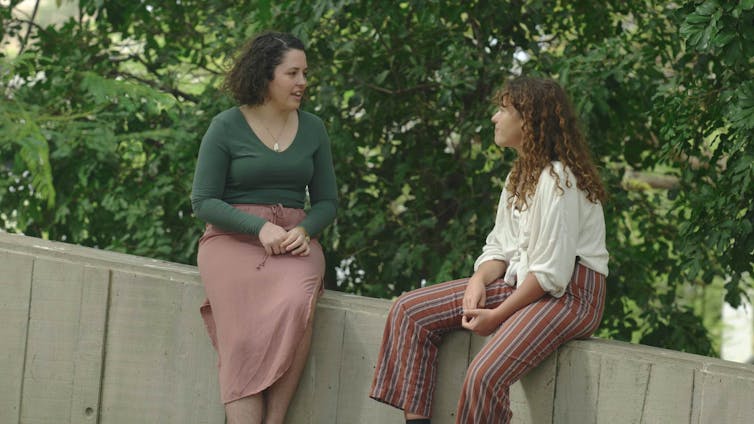
In the coal export capital of Australia, many of these rights offer natural avenues for climate change arguments.
For example, climate change will create significant drawbacks for human health in Queensland, such as from increased vulnerability to heat illnesses, further spreading of tropical diseases and mental health impacts. This is arguably a violation of the right to life.
Read more: Australia listened to the science on coronavirus. Imagine if we did the same for coal mining
The legislation makes it unlawful for a public entity, such as a state government, to make a decision that isn’t compatible with human rights, or to fail to give proper consideration to relevant human rights when making a decision.
The legislation also limits when the human rights argument can be used. A litigant can’t bring a new claim to court, based solely on the human rights legislation. They can only use the human rights act to support their argument if they can argue a decision is also unlawful under a different act, such as the Youth Verdict using the act to object to the existing draft state environmental approval.
An Exciting New Chapter
Youth Verdict will have to make the case that the human rights of its younger members will be affected as a result of this project’s contributions to climate change – beyond an extent that’s demonstrably justifiable under the act.
While it’s difficult to predict the likely success of this case, progress towards a future successful climate change case has already been made in Queensland, and this case will build on that momentum.
It may also trigger a broader trend of human rights-based climate change cases in Queensland, and possibly in Victoria and the ACT, as young people take inspiration from their interstate peers.
What’s more, these cases might be immune from one of the biggest problems with successful climate change cases: negative legislative backlash, prompting politicians to repeal laws.
For example, following the successful Rocky Hill case in NSW, the government introduced legislation to remove Scope 3 emissions from consideration in mining approvals decisions.
But the political ramifications of winding back humans rights protections would be enormous, so it’s likely Queensland’s new legislation is here to stay.
Certainly, this is the start of an exciting new chapter in Queensland’s climate change litigation history, and a bright spark of hope.
Correction: an earlier version of this article named Matt Canavan as the Minister for Resources. This has been changed to reflect that he is the former resources minister.![]()
Justine Bell-James, Associate professor, The University of Queensland
This article is republished from The Conversation under a Creative Commons license. Read the original article.
Bimblebox Nature Reserve
Readers of the above article may be interested in knowing more about one of the areas the proposed mine would impact on. Bimblebox Nature Refuge is threatened by a massive new thermal coal development proposed by Waratah Coal, owned by Clive Palmer. Its Galilee Coal Project (formerly called ‘China First’) would involve open cut mining more than half of Bimblebox Nature Refuge and underground mining the remainder.
The proposal over a legally ‘protected’ conservation property was approved by both the Queensland and Federal Governments in 2013.
In October 2019 Waratah Coal lodged an application for a Mining Lease and Environmental Authority.
Bimblebox Nature Refuge is an almost 8000 hectare, 95% uncleared sanctuary in central west Queensland, approximately 500 km west of Rockhampton and 30km north west of the town of Alpha. It is composed of remnant semi-arid woodlands with an understorey largely made up of native shrubs, forbs and grasses, and has a rich diversity of birds (176 species recorded so far), reptiles and other animals. In May 2011 a flock of endangered Black Throated Finch (Poephila cincta cincta) was sighted on Bimblebox, which has been confirmed by Birds Australia.
Bimblebox is a rare example of how agricultural production and biodiversity conservation can co-exist. A small herd of beef cattle assist in the control of exotic pasture grasses, and a number of long-term research projects are aimed at generating knowledge and management practices to improve outcomes for biodiversity across the region.
Formerly Glen Innes Station, Bimblebox was secured in 2000, when Queensland’s land clearing rates were amongst the highest in the world. It was purchased with the savings of a number of concerned individuals, as well as funding from the Australian National Reserve System program,’Caring for our Country’, to save it from being cleared.
In 2002, as required, the Bimblebox Nature Refuge Agreement (category VI IUCN protected area) was signed with the Queensland state government to permanently protect the high conservation values of the property. Nature Refuges and the protected areas that make up the National Reserve System are not automatically protected from mineral exploration and mining, which in Australia are granted rights over almost all other land uses. The Bimblebox team has lodged comments on the Queensland Draft Biodiversity Strategy for Queensland addressing this very issue.
These legal conservation contracts with both state and federal governments were signed before Waratah Coal’s exploration permit was issued. It covers all of Bimblebox and parts of the surrounding properties.
In late September 2011 the company released its Environmental Impact Statement (EIS) . It detailed plans to extract 40 mega-tonnes of coal per year, which will be transported on a yet-to-be-built 468 km rail line up to Abbot Point and shipped through the Great Barrier Reef on its way to China where it will be burnt for energy generation. Lately (2019) Mr Palmer has talked of a pipeline carrying ‘coal sludge’ instead of a rail line.
The project was approved by the Queensland Government in August 2013, and by the Federal Government on 19 December 2013. Waratah Coal still needed to apply for a Mining Lease and Environmental Authority. In October 2019 Waratah Coal made those final two applications public.
A precedent-setting test case
As we understand it, Bimblebox is the first protected area to face the threat of mining to the degree proposed by Waratah Coal’s proposed mine. According to the Bimblebox teams' research, a third of the 453 Nature Refuges (2014)throughout Queensland are threatened by coal exploration and potential mining. The Waratah mine is totally against the wishes of the owners, and against the values they signed to protect.
It will also serve as a test case as to whether the Queensland State and Australian Federal governments are willing to alter outdated legislation so that conservation values are considered to be at least of similar importance to the state as large mining projects.
If Bimblebox survives the current coal mine threat, it is likely to continue to be an important long-term research site, an example of sustainable rangeland grazing, and one of the very few large areas of intact remnant habitat remaining in the bioregion. Others that existed even in 2011 have now been cleared.
The QLD Environment Department advised in 2011 that proposed clearing on Bimblebox Nature Refuge for Clive Palmer’s Waratah Coal mine would kill about 35,880 birds, 13,570 mammals and 780,000 reptiles. There would also be destruction of many rare plants.These figures lead those currently taking the case to court to point that this would be a Federal and State-sanctioned massacre.
More at: https://bimblebox.org/ and: https://www.facebook.com/Bimblebox/ and: https://www.facebook.com/youthverdict

Bimblebox Nature Refuge photo
A long way to the top: Australian musicians balance multiple roles to make their careers work

Over the past three years, our Making Music Work project has mapped the creative, social, cultural, and economic realities of a music career in Australia.
We surveyed nearly 600 musicians to understand their working lives, creative goals, career paths and economic circumstances. We also conducted interviews with 11 diverse musicians to explore their careers in more depth.
Our study shows the vast majority of Australian musicians undertake a portfolio career which encompasses concurrent and often impermanent roles. This is not a new phenomenon but in recent decades there have been major shifts in how music is made, paid for and consumed.
Now, the impact of COVID-19 on the funding and policy landscape has dramatically affected how musicians develop and sustain their careers – or not.
Balancing Acts
Musicians told us they stay in the music industry because of their love and passion for music, which is central to their identity. Far from the “starving artist” myth, they combine music and non-music work in highly entrepreneurial ways. Surveyed before the current crisis, almost half (49%) the musicians in our study held two or more concurrent paid roles.
We found 560 different job titles, the most common being instrumental musician (25%) and private music teacher (10%). Musicians worked in music-related jobs as disparate as composers, sound technicians and community arts workers, and non-music jobs including sales assistants, journalists and librarians.
We spoke to musicians from 18 years old to 65 and above. Almost 70% had worked in music for more than 10 years, with nearly one in three of them practising as professional musicians for more than 20 years. This gives an indication of how committed Australian musicians are to the industry and sustaining their music careers and creative practice over time.
While most musicians we studied are committed to the profession, 12% said that they were thinking about leaving.
The most common reasons for leaving the music industry were financial stress, lack of income and caring responsibilities – all of which have since been exacerbated by the pandemic.
A Live Industry
Performance is the most common paid activity for musicians, with two-thirds of musicians deriving at least some of their income from performance fees.
Live performances are also crucial for peer networking and career development. Peer networks are mostly built and maintained through events, and are key to musicians’ building and renewing skills, developing new creative collaborations and securing jobs.
Given live music was immediately impacted by the COVID-19 restrictions and will be slow to return, the capacity of musicians to maintain their careers has been severely limited.
Federal, state and local governments have initiated a range of targeted grants and subsidies to help support the sector and its workforce. However, lobby groups and representative bodies have called for significantly more funding.
Read more: Friday essay: the politics of dancing and thinking about cultural values beyond dollars
On 10 June, music rights organisation APRA AMCOS published an open letter with more than 1,000 industry signatories imploring the Australian government to consider a suite of proposals.
In making their case, the signatories assert:
[w]e contribute $16 billion to the economy and we are an asset that is a lynchpin for the tourism and hospitality sectors and a powerful driver of metropolitan and regional economies and export to the world.
The Employment Puzzle
Musicians are predominantly self-employed or are employed on temporary contracts, leaving them ineligible for the current JobKeeper scheme.
Only half of musicians receive all of their income from music-related work, and the most common sources of music-related income are performance fees, music teaching and grants. The average income from all work was $41,257, with a median income of $30,576.
While the Australian government has permitted early release of superannuation in response to COVID-19, our study has shown that musicians have limited access to this and other employment-related benefits.
Less than one-third of our survey participants reported employer-based superannuation contributions, and only 7% had access to a health plan or private health insurance scheme.
Read more: The government says artists should be able to access JobKeeper payments. It's not that simple
Cause For Hope
In spite of the challenges, Australian musicians have shown tremendous creativity and resilience in adapting their work to online environments during the pandemic.
Musicians’ resilience is unsurprising given how creatively and financially nimble they have to be when negotiating music and non-music roles. To successfully engage across a variety of markets, genres and performance sites, musicians deploy diverse and agile skill sets. If they were to receive similar support as other sectors of the economy in this current crisis, they would be well placed to survive and thrive into the future.
Throughout our research, Australian musicians generously shared their expertise. They recognise the crucial role of peer networks to develop creative practices, sustain livelihoods and nurture the sector. This creative generosity will be central to the industry’s recovery from COVID-19.
Scott Harrison, Vanessa Tomlinson and Paul Draper also contributed to this research.![]()
Brydie-Leigh Bartleet, Professor and Director, Queensland Conservatorium Research Centre, Griffith University, Griffith University; Ben Green, Postdoctoral resident adjunct, Griffith Centre for Social and Cultural Research, Griffith University; Christina Ballico, Adjunct research fellow, Griffith University; Dawn Bennett, Professor of Higher Education, Curtin University, and Ruth Bridgstock, Director of Curriculum and Teaching Transformation, Professor of Learning Futures, Griffith University
This article is republished from The Conversation under a Creative Commons license. Read the original article.
Almost 90% of astronauts have been men. But the future of space may be female
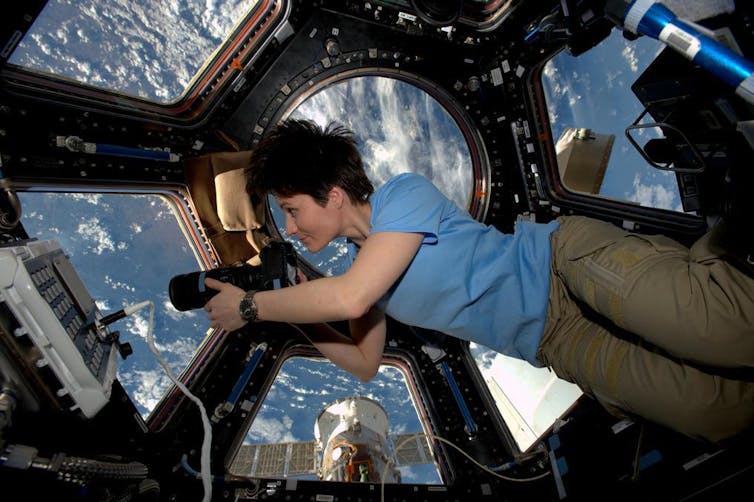
Only 566 people have ever travelled to space. Sixty-five of them, or about 11.5%, were women.
NASA recently proclaimed it will put the “first woman and next man” on the Moon by 2024. Despite nearly 60 years of human spaceflight, women are still in the territory of “firsts”.
Valentina Tereshkova, The First Woman In Space
The first woman in space was cosmonaut Valentina Vladimirovna Tereshkova, who orbited Earth 48 times from June 16 to 18, 1963.
Her flight became Cold War propaganda to demonstrate the superiority of communism. At the 1963 World Congress of Women, Soviet leader Nikita Khrushchev used Tereshkova’s voyage to declare the USSR had achieved equality for women.
Women across the world took heart and dreamed they too might travel to space. Ekaterina Ergardt, a Soviet state farm worker, wrote to Tereshkova:
I am eighty years old. I started to live in the years of the beginning of women’s struggle for a life of freedom and equality … now the road to space is open for women.
Earthbound Again
Despite this optimism, it was 19 years before another woman was allowed to venture beyond Earth.
In the United States, women were excluded from space by the restriction that astronauts had to be military test pilots – a profession barred to them.
While the first American astronauts – known as the Mercury 7 – were training in the 1960s, aerospace doctor Randy Lovelace recruited 13 women pilots and put them through the same paces as the male astronauts. The “Mercury 13” outperformed the men on many tests, particularly in how they handled isolation.
But NASA wasn’t convinced. A congressional hearing was held to investigate whether women should qualify to be astronauts. In her testimony, Mercury 13 astronaut candidate Jerrie Cob said:
I find it a little ridiculous when I read in a newspaper that there is a place called Chimp College in New Mexico where they are training chimpanzees for space flight, one a female named Glenda. I think it would be at least as important to let the women undergo this training for space flight.
She was prepared to take the place of a chimp, if that was the only way to get into space.
Message In A Bottle
Historically, even those like Lovelace who believed women should go to space have seen their role as helping men, acting as a civilising influence, or providing sex.
In one sense the first women on the Moon were Playboy playmates, in the form of pictures jokingly included in the Apollo 12 astronauts’ checklists. Their names were Cynthia Myers, Angela Dorian, Reagan Wilson, and Leslie Bianchini. The women’s bodies were likened to the lunar landscape: both the object of male conquest.
In popular culture in the 1960s, women were often associated with magic and emotion rather than science and technology.
The sitcom I Dream of Jeannie depicted the relationship between a US astronaut and a magical djinn or genie, imaginatively named Jeannie. NASA was an advisor for the series, which mirrored real space events. Jeannie represented seductive oriental femininity in opposition to the strait-laced, masculine, all-American astronauts.

(In the similar sitcom Bewitched, the witch Samantha travelled to the Moon for picnics before she renounced her craft to be a regular housewife.)
The message was clear in popular culture: women needed to stay in the kitchen – or the boudoir. These sitcoms are still aired around the world.
Read more: 'I Dream of Jeannie' left us with enduring stereotypes
From Aprons To Spacewalks
By the 1970s, the women’s movement had made great strides and NASA had to adapt. The first women were admitted to astronaut training in 1978. Not to be outdone, the USSR rushed more women into its own program.
In 1982 Svetlana Savitskaya visited the Salyut 7 space station, becoming the second woman in space and the first to perform a spacewalk. But she wasn’t allowed to forget the nature of women’s work: when she arrived, her male colleagues presented her with an apron.
The following year, Sally Ride flew as a mission specialist on the Space Shuttle Challenger, becoming the first US woman in space. The first American woman to spacewalk was Kathryn Sullivan in 1995.
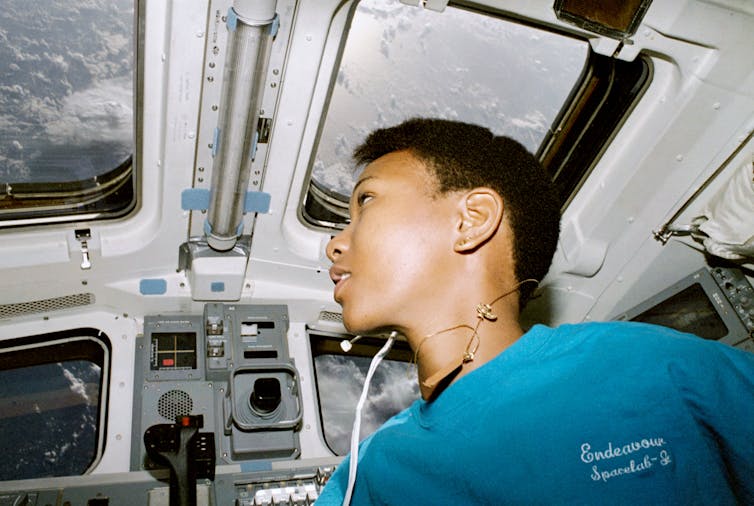
In the 21st century, there are still barriers to women’s equal participation in space. In March 2019 the first all-woman spacewalk was cancelled because there were not enough medium-sized spacesuits. Astronauts Christina Koch and Jessica Meir subsequently accomplished the feat in October 2019.
Discussing the cancellation, NASA administrator Ken Bowersox made clear the ideal astronaut body is still male. He blamed women’s smaller average stature, saying they were less able to “reach in and do things a little bit more easily”.
‘Weightlessness Is A Great Equalizer’
Is it women’s bodies that are the problem, or a space world built for men? What would space technology designed by and for women look like?
There is a massive gender data gap in space. There has been much less research on the effects of microgravity on women’s bodies than there has been for men.
However, women in many ways are ideal astronauts. Physical strength and height are not advantages in microgravity.
Women use less food and oxygen, maintain their weight better on restricted diets, and create less waste. In the words of Sally Ride, “weightlessness is a great equaliser”.
Space4Women
Women’s access to space, not just as astronauts but as users and creators of space services like Earth observation and satellite telecommunications, is still far from equal. But there are signs of progress.
One is the Space4Women program run by the United Nations Office of Outer Space Affairs (UNOOSA), which aims to ensure
the benefits of space reach women and girls and that women and girls play an active and equal role in space science, technology, innovation, and exploration.
As UNOOSA director Simonetta di Pippo has noted, 40% of the targets of the UN’s sustainable development goals rely on the use of space science and technology.
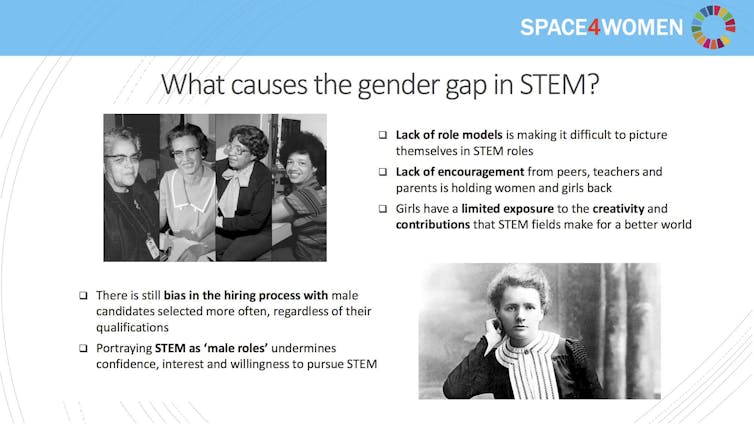
NASA’s plan to land a woman on the Moon is another positive sign. On her post-orbit world tour in 1964, Valentina Tereshkova expressed her own desire to go to the Moon, but she never made another spaceflight.
Now aged 83, Dr Tereshkova has had a distinguished career in science and politics and remains a sitting member of the Russian parliament. To see a woman set foot on the lunar surface within her lifetime would truly be a ground-breaking moment.![]()
Alice Gorman, Associate Professor in Archaeology and Space Studies, Flinders University
This article is republished from The Conversation under a Creative Commons license. Read the original article.
Greens Push To Ban Dirty Political Donations And Restore Democracy
Abalone Relocation Makes Way For W.A. Ocean Reef Marina Development
- development of monitoring and management plans to minimise any impacts to marine water quality outside the marina and adjacent beaches;
- translocation of Roe's abalone; and
- measures to improve the management and protection of similar marine nearshore habitats in the Marmion Marine Park.
Three More New Schools Get Tick Of Approval: At Camden, Blacktown And Wagga Wagga
- a $48 million public school for 1,000 students in Marsden Park, Blacktown;
- a $36 million public school for 480 students at Estella Road, Wagga Wagga; and
- a $43 million public school for 1,000 students in Catherine Field.
How To Reduce Wood Smoke Pollution This Winter
- Burn only dry, aged hardwood.
- Store freshly cut wood in a dry, ventilated area for at least eight to 12 months.
- Never burn rubbish, driftwood, painted or treated wood.
- When lighting a cold heater, use plenty of dry kindling to establish a fire quickly.
- Open the air controls fully for five minutes before and 15 to 20 minutes after loading the heater.
- Have the chimney cleaned at least once a year to prevent tar build-up.
- Don’t let your heater smoulder overnight – keep enough air in the fire to maintain a flame.
- Choose an appropriate heating system for your home. One that retains the heat you put into it.
- Check your chimney regularly to see how well your fire is burning. If smoke is coming from the chimney, increase the air supply to your fire.
- For new wood heaters, make sure they have a compliance plate showing they meet the Australian Standard (AS/NZS 4012:2014 and AS/NZS4013:2014).
Cricket Australia Resets Operations For Post-COVID Environment
- Protecting the long-term integrity of the game starting at the grassroots by retaining our commitment to Alinta Energy My Cricket, Woolworths Cricket Blast programs, junior cricket initiatives and continuing to invest in community facilities and technology platforms;
- Ensuring the elite men’s and women’s teams are appropriately and prudently resourced, including our commitment to support mental health and wellbeing;
- Continuing the Marsh Sheffield Shield, WNCL and Marsh Cup in their current formats for the FY20-21 season and maintaining the current number of games for rebel WBBL and KFC BBL;
- Pausing international tours for Australia A teams, as well as CA XI fixtures, the Fox Cricket National Premier Cricket T20 and Toyota Second XI competitions for FY21;
- Retaining the U19s male and female representative teams as an important part of the pathway for emerging talent, while pausing male U15s and U17s and female U15s representative teams for FY21;
- Providing the States and Territories with greater autonomy to develop players in readiness for the elite level, addressing a long-standing request for change and significantly reducing costs of duplicate efforts at state and national level;
- Retaining our commitment to work with States and Territories to support programs and championships that foster diversity and inclusion, including the National Cricket Inclusion Championships, National Indigenous Cricket Championships and Toyota Australian Country Cricket Championships;
- Reducing budgets in areas including administration, travel and marketing and advertising;
- Cutting all bonuses for senior management and implementing ongoing executive pay reductions
Disclaimer: These articles are not intended to provide medical advice, diagnosis or treatment. Views expressed here do not necessarily reflect those of Pittwater Online News or its staff.